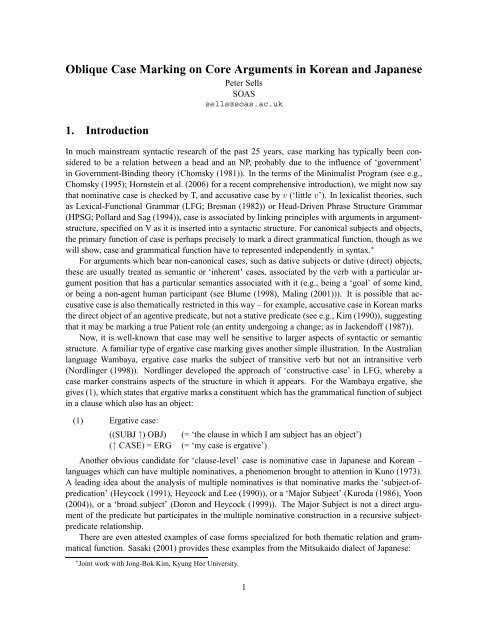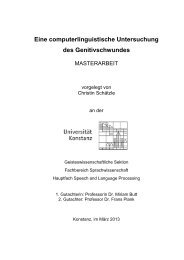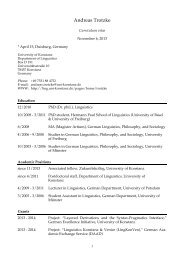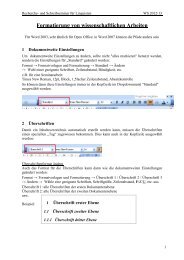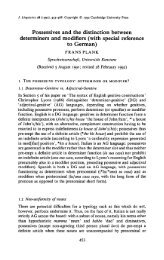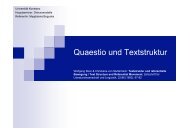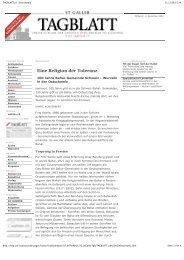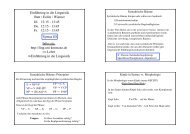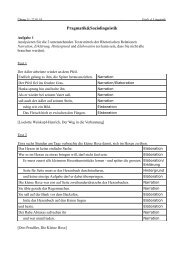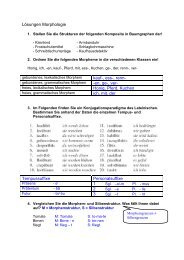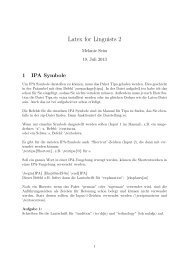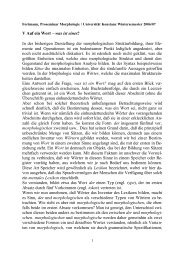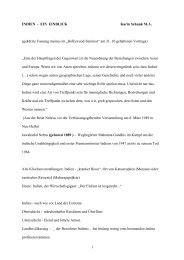Oblique Case Marking on Core Arguments in Korean and Japanese
Oblique Case Marking on Core Arguments in Korean and Japanese
Oblique Case Marking on Core Arguments in Korean and Japanese
Create successful ePaper yourself
Turn your PDF publications into a flip-book with our unique Google optimized e-Paper software.
<str<strong>on</strong>g>Oblique</str<strong>on</strong>g> <str<strong>on</strong>g>Case</str<strong>on</strong>g> <str<strong>on</strong>g>Mark<strong>in</strong>g</str<strong>on</strong>g> <strong>on</strong> <strong>Core</strong> <strong>Arguments</strong> <strong>in</strong> <strong>Korean</strong> <strong>and</strong> <strong>Japanese</strong><br />
Peter Sells<br />
SOAS<br />
sells@soas.ac.uk<br />
1. Introducti<strong>on</strong><br />
In much ma<strong>in</strong>stream syntactic research of the past 25 years, case mark<strong>in</strong>g has typically been c<strong>on</strong>sidered<br />
to be a relati<strong>on</strong> between a head <strong>and</strong> an NP, probably due to the <strong>in</strong>fluence of ‘government’<br />
<strong>in</strong> Government-B<strong>in</strong>d<strong>in</strong>g theory (Chomsky (1981)). In the terms of the M<strong>in</strong>imalist Program (see e.g.,<br />
Chomsky (1995); Hornste<strong>in</strong> et al. (2006) for a recent comprehensive <strong>in</strong>troducti<strong>on</strong>), we might now say<br />
that nom<strong>in</strong>ative case is checked by T, <strong>and</strong> accusative case by v (‘little v’). In lexicalist theories, such<br />
as Lexical-Functi<strong>on</strong>al Grammar (LFG; Bresnan (1982)) or Head-Driven Phrase Structure Grammar<br />
(HPSG; Pollard <strong>and</strong> Sag (1994)), case is associated by l<strong>in</strong>k<strong>in</strong>g pr<strong>in</strong>ciples with arguments <strong>in</strong> argumentstructure,<br />
specified <strong>on</strong> V as it is <strong>in</strong>serted <strong>in</strong>to a syntactic structure. For can<strong>on</strong>ical subjects <strong>and</strong> objects,<br />
the primary functi<strong>on</strong> of case is perhaps precisely to mark a direct grammatical functi<strong>on</strong>, though as we<br />
will show, case <strong>and</strong> grammatical functi<strong>on</strong> have to represented <strong>in</strong>dependently <strong>in</strong> syntax. ∗<br />
For arguments which bear n<strong>on</strong>-can<strong>on</strong>ical cases, such as dative subjects or dative (direct) objects,<br />
these are usually treated as semantic or ‘<strong>in</strong>herent’ cases, associated by the verb with a particular argument<br />
positi<strong>on</strong> that has a particular semantics associated with it (e.g., be<strong>in</strong>g a ‘goal’ of some k<strong>in</strong>d,<br />
or be<strong>in</strong>g a n<strong>on</strong>-agent human participant (see Blume (1998), Mal<strong>in</strong>g (2001))). It is possible that accusative<br />
case is also thematically restricted <strong>in</strong> this way – for example, accusative case <strong>in</strong> <strong>Korean</strong> marks<br />
the direct object of an agentive predicate, but not a stative predicate (see e.g., Kim (1990)), suggest<strong>in</strong>g<br />
that it may be mark<strong>in</strong>g a true Patient role (an entity undergo<strong>in</strong>g a change; as <strong>in</strong> Jackendoff (1987)).<br />
Now, it is well-known that case may well be sensitive to larger aspects of syntactic or semantic<br />
structure. A familiar type of ergative case mark<strong>in</strong>g gives another simple illustrati<strong>on</strong>. In the Australian<br />
language Wambaya, ergative case marks the subject of transitive verb but not an <strong>in</strong>transitive verb<br />
(Nordl<strong>in</strong>ger (1998)). Nordl<strong>in</strong>ger developed the approach of ‘c<strong>on</strong>structive case’ <strong>in</strong> LFG, whereby a<br />
case marker c<strong>on</strong>stra<strong>in</strong>s aspects of the structure <strong>in</strong> which it appears. For the Wambaya ergative, she<br />
gives (1), which states that ergative marks a c<strong>on</strong>stituent which has the grammatical functi<strong>on</strong> of subject<br />
<strong>in</strong> a clause which also has an object:<br />
(1) Ergative case:<br />
((SUBJ ↑) OBJ)<br />
(↑ CASE) = ERG<br />
(= ‘the clause <strong>in</strong> which I am subject has an object’)<br />
(= ‘my case is ergative’)<br />
Another obvious c<strong>and</strong>idate for ‘clause-level’ case is nom<strong>in</strong>ative case <strong>in</strong> <strong>Japanese</strong> <strong>and</strong> <strong>Korean</strong> –<br />
languages which can have multiple nom<strong>in</strong>atives, a phenomen<strong>on</strong> brought to attenti<strong>on</strong> <strong>in</strong> Kuno (1973).<br />
A lead<strong>in</strong>g idea about the analysis of multiple nom<strong>in</strong>atives is that nom<strong>in</strong>ative marks the ‘subject-ofpredicati<strong>on</strong>’<br />
(Heycock (1991), Heycock <strong>and</strong> Lee (1990)), or a ‘Major Subject’ (Kuroda (1986), Yo<strong>on</strong><br />
(2004)), or a ‘broad subject’ (Dor<strong>on</strong> <strong>and</strong> Heycock (1999)). The Major Subject is not a direct argument<br />
of the predicate but participates <strong>in</strong> the multiple nom<strong>in</strong>ative c<strong>on</strong>structi<strong>on</strong> <strong>in</strong> a recursive subjectpredicate<br />
relati<strong>on</strong>ship.<br />
There are even attested examples of case forms specialized for both thematic relati<strong>on</strong> <strong>and</strong> grammatical<br />
functi<strong>on</strong>. Sasaki (2001) provides these examples from the Mitsukaido dialect of <strong>Japanese</strong>:<br />
∗ Jo<strong>in</strong>t work with J<strong>on</strong>g-Bok Kim, Kyung Hee University.<br />
1
(2) a. ora mango-nge s<strong>in</strong>bun yom-ase-da<br />
1sg.NOM gr<strong>and</strong>child-DAT newspaper-ACC read-CAUS-PST<br />
‘I made my gr<strong>and</strong>child read the newspaper.’<br />
b. ore-nganya eengo wagan-ne<br />
1sg-EXP.TOP English underst<strong>and</strong>-NEG.PRS<br />
‘I d<strong>on</strong>’t underst<strong>and</strong> English.’<br />
The regular dative marker is nge, as <strong>in</strong> (2)a, while the experiencer-subject-topic <strong>in</strong> (2)b is marked<br />
with nganya. The form ngani would be used to mark an experiencer that is subject but not topic.<br />
St<strong>and</strong>ard <strong>Japanese</strong> would have ni-wa for the topic form <strong>and</strong> ni for the others. Sasaki c<strong>on</strong>cludes that<br />
case markers can be specialized both for thematic role <strong>and</strong> grammatical functi<strong>on</strong>.<br />
Work<strong>in</strong>g from a broader c<strong>on</strong>ceptual foundati<strong>on</strong>, Spencer (2003) argues that while it makes sense<br />
to th<strong>in</strong>k of case as c<strong>on</strong>stra<strong>in</strong><strong>in</strong>g its envir<strong>on</strong>ment <strong>in</strong> the ways just alluded to, the apparent ‘directi<strong>on</strong>’ of<br />
the analysis <strong>in</strong> a proposal such as Nordl<strong>in</strong>ger’s is backwards – rather, what we really need to start with<br />
is the overall structure, <strong>and</strong> then assign case to NPs based <strong>on</strong> properties of the structure. In Wambaya,<br />
if we f<strong>in</strong>d that we have a transitive clause, then we state that the subject NP of that clause is marked<br />
with ergative case. This is part of a grow<strong>in</strong>g body of work <strong>in</strong> ‘Realizati<strong>on</strong>al Morphology’, develop<strong>in</strong>g<br />
the program laid out <strong>in</strong> Stump (2001), with regard to clausal properties such as case, tense, <strong>and</strong> so <strong>on</strong>.<br />
Relevant work <strong>in</strong> the Lexical-Functi<strong>on</strong>al Grammar framework <strong>in</strong>cludes Sadler <strong>and</strong> Spencer (2001),<br />
Sadler <strong>and</strong> Nordl<strong>in</strong>ger (2004), Sells (2000, 2004b), am<strong>on</strong>g many others, which assumes that morphology<br />
is an (imperfect) realizati<strong>on</strong> of clausal syntactic properties. A realizati<strong>on</strong>al approach with<strong>in</strong> HPSG<br />
can be found <strong>in</strong> M<strong>on</strong>achesi (2001). The underly<strong>in</strong>g c<strong>on</strong>cepti<strong>on</strong> is shared with Distributed Morphology<br />
(see e.g., Halle <strong>and</strong> Marantz (1993)), namely that of a syntactic structure with features <strong>and</strong> properties<br />
which is ‘<strong>in</strong>terpreted’ morpho-ph<strong>on</strong>ologically.<br />
Spencer’s approach would suggest that there are uses of case mark<strong>in</strong>g which are def<strong>in</strong>ed with<strong>in</strong><br />
the clause but which may not be reducible directly to properties of some lexical or functi<strong>on</strong>al head<br />
with<strong>in</strong> the clause, or which may not be associated with an identifiable thematic role such as Patient or<br />
Goal. In this paper we discuss examples from <strong>Korean</strong> <strong>and</strong> <strong>Japanese</strong> <strong>in</strong> which case markers or other<br />
types of mark<strong>in</strong>g <strong>on</strong> NP systematically <strong>in</strong>dicate mean<strong>in</strong>gs which go bey<strong>on</strong>d thematic properties, <strong>and</strong><br />
which br<strong>in</strong>g out the limitati<strong>on</strong>s of current views of the expressive potential of case.<br />
2. <strong>Korean</strong> <str<strong>on</strong>g>Oblique</str<strong>on</strong>g> Subjects<br />
In additi<strong>on</strong> to the familiar dative subjects of possessive verbs, am<strong>on</strong>g others (as <strong>in</strong> (3); see e.g., Yo<strong>on</strong><br />
(2004)), <strong>Korean</strong> allows other true apparently oblique <strong>and</strong> n<strong>on</strong>-nom<strong>in</strong>ative subjects:<br />
(3) cheli-eykey t<strong>on</strong>-i manh-ta<br />
Cheli-DAT m<strong>on</strong>ey-NOM much-DECL<br />
‘Cheli has much m<strong>on</strong>ey.’<br />
It is unc<strong>on</strong>troversial that <strong>Korean</strong> markers of case occupy two dist<strong>in</strong>ct morphological positi<strong>on</strong>s, relative<br />
to the (preced<strong>in</strong>g) nouns. Roughly speak<strong>in</strong>g, the first slot is for postpositi<strong>on</strong>al markers, <strong>and</strong> the sec<strong>on</strong>d<br />
for structural case markers or the topic marker (see e.g., Cho <strong>and</strong> Sells (1995)), as <strong>in</strong> (4). 1<br />
1 It is more c<strong>on</strong>troversial whether <strong>Japanese</strong> (<strong>and</strong> <strong>Korean</strong>) actually have any formal case values at all, rather than simply<br />
case forms (see Spencer <strong>and</strong> Otoguro (2005)). Our evidence suggests that <strong>Korean</strong> grammar requires reference to case feature<br />
values, not just case forms, though there is no comparable evidence <strong>in</strong> <strong>Japanese</strong>.<br />
2
(4) <strong>Korean</strong> adpositi<strong>on</strong>al markers:<br />
Postpositi<strong>on</strong>s <str<strong>on</strong>g>Case</str<strong>on</strong>g>/Topic<br />
eyse (2.2) ‘at’ i/ka NOM<br />
pwuthe (3) ‘from’ (l)ul ACC<br />
(u)lo ‘with’ (n)un TOP<br />
eykey DAT uy GEN<br />
hanthey DAT<br />
kkey HON.DAT<br />
kkeyse (2.1) HON.SUBJ<br />
In what follows these two positi<strong>on</strong>s are referred to <strong>in</strong> terms of ‘slots’, without suppos<strong>in</strong>g any particular<br />
details of morphological analysis. As case markers have two structural positi<strong>on</strong>s <strong>in</strong> the overall morphological<br />
form, it is possible sometimes for both positi<strong>on</strong>s to be expressed, giv<strong>in</strong>g the phenomen<strong>on</strong><br />
known as ‘case-stack<strong>in</strong>g’ (see e.g., Schütze (2001), Yo<strong>on</strong> (2004)).<br />
2.1. kkeyse Subjects<br />
The subjects of <strong>Korean</strong> verbs which are of a socially superior status may be marked with the h<strong>on</strong>orific<br />
subject marker kkeyse, <strong>in</strong> which case the verb also takes a subject-h<strong>on</strong>orific suffix si. Compare the<br />
n<strong>on</strong>-h<strong>on</strong>orific example <strong>in</strong> (5)a with its h<strong>on</strong>orific counterpart: 2<br />
(5) a. haksayng-tul-i o-ass-ta<br />
student-PLU-NOM come-PST-DECL<br />
‘The students came.’<br />
b. sensayng-nim-tul-kkeyse o-si-ess-ta<br />
teacher-HON-PLU-kkeyse come-HON-PST-DECL<br />
‘The teachers came.’<br />
Yo<strong>on</strong> (2005) argues that while kkeyse is a pure subject marker, for h<strong>on</strong>orific subjects, its case is<br />
n<strong>on</strong>-nom<strong>in</strong>ative, <strong>and</strong> that the NP it marks is an ablative oblique. We will show that the case of kkeyse<br />
is <strong>in</strong> fact nom<strong>in</strong>ative, lead<strong>in</strong>g to the c<strong>on</strong>clusi<strong>on</strong> that structural case is not solely associated with the<br />
f<strong>in</strong>al suffix slot <strong>in</strong> (4), follow<strong>in</strong>g the proposal <strong>in</strong> Sells (1995).<br />
One fact to observe about kkeyse-marked subjects is that they allow case-stack<strong>in</strong>g with i/ka under<br />
the right circumstances. <str<strong>on</strong>g>Case</str<strong>on</strong>g>-stack<strong>in</strong>g is illustrated <strong>in</strong> (6), where both subjects have a marker which<br />
is <strong>in</strong> the postpositi<strong>on</strong> slot, but also a structural case marker of nom<strong>in</strong>ative: 3<br />
(6) a. cheli-eykey-ka t<strong>on</strong>-i manh-ta (cf. (3))<br />
Cheli-DAT-NOM m<strong>on</strong>ey-NOM much-DECL<br />
‘Cheli has much m<strong>on</strong>ey.’<br />
b. sensayng-nim-tul-kkeyse-man-i o-si-ess-ta (cf. (5)b)<br />
teacher-HON-PLU-kkeyse-<strong>on</strong>ly-NOM come-HON-PST-DECL<br />
‘Only the teachers came.’<br />
2 Many of the h<strong>on</strong>orable nouns <strong>in</strong> the examples <strong>in</strong> this secti<strong>on</strong> bear the h<strong>on</strong>orific marker nim, mean<strong>in</strong>g ‘h<strong>on</strong>orable pers<strong>on</strong>’.<br />
This marker functi<strong>on</strong>s as part of the noun stem <strong>and</strong> is not part of the case-mark<strong>in</strong>g system.<br />
3 It is not possible to stack a structural nom<strong>in</strong>ative directly after kkeyse (*kkeyse-ka is ungrammatical). (6)b is possible as<br />
stacked nom<strong>in</strong>ative also has a focus-related use (see Schütze (2001), Yo<strong>on</strong> (2004)), which the suffix man (‘<strong>on</strong>ly’) facilitates.<br />
3
In additi<strong>on</strong> to h<strong>on</strong>orificati<strong>on</strong>, the c<strong>on</strong>trol c<strong>on</strong>structi<strong>on</strong> <strong>in</strong>dicates that a kkeyse-marked phrase functi<strong>on</strong>s<br />
as the subject. Such a phrase may c<strong>on</strong>trol the embedded subject of a predicate like try, as <strong>in</strong><br />
(7)a, as well <strong>in</strong>to a myense(to) (‘although’) clause, whose unexpressed subject of this clause must be<br />
the matrix subject, as <strong>in</strong> (7)b (see Youn (1989)):<br />
(7) a. sensayng-nim-kkeyse [haksayng-ul manna-lyeko] nolyek ha-si-ess-ta<br />
teacher-HON-kkeyse [student-ACC meet-COMP] try-HON-PST-DECL<br />
‘The teacher tried to meet the students.’<br />
b. [pappu-si-myense(-to)] sensayng-nim-kkeyse [haksayng-ul manna-lyeko]<br />
[busy-although(-even)] teacher-HON-kkeyse [student-NOM meet-COMP]<br />
nolyekha-si-ess-ta<br />
try-HON-PST-DECL<br />
‘Although the teacher was busy, he tried to meet the students.’<br />
Rais<strong>in</strong>g c<strong>on</strong>structi<strong>on</strong>s also <strong>in</strong>dicate that the kkeyse-phrase is the subject:<br />
(8) a. na-nun [sensayng-nim-kkeyse hyenmyeng ha-si-ess-ta-ko] mit-nun-ta<br />
I-TOP [teacher-HON-kkeyse wise do-HON-PST-DECL-COMP] believe-PROC-DECL<br />
‘I believe that the teacher was wise.’<br />
b. na-nun sensayng-nim-ul [hyenmyeng ha-si-ta-ko] mit-nun-ta<br />
I-TOP teacher-HON-ACC [wise do-HON-DECL-COMP] believe-PROC-DECL<br />
‘I believe the teacher to be wise.’<br />
In (8)b, the phrase raised to object positi<strong>on</strong> is the noti<strong>on</strong>al subject of the lower clause, marked with<br />
kkeyse <strong>in</strong> the unraised versi<strong>on</strong> <strong>in</strong> (8)a.<br />
<strong>Korean</strong> has a ‘multiple subject’ c<strong>on</strong>structi<strong>on</strong> <strong>in</strong> which successive nom<strong>in</strong>ative NPs st<strong>and</strong> <strong>in</strong> a possessive<br />
relati<strong>on</strong>. A kkeyse-marked phrase can corresp<strong>on</strong>d to either NP <strong>in</strong> such a c<strong>on</strong>structi<strong>on</strong>:<br />
(9) a. cheli-ka ape-nim-kkeyse pwuca-i-*(si)-ta<br />
cheli-NOM father-HON-kkeyse rich-COP-*(HON)-DECL<br />
‘It is Cheli whose father is rich.’<br />
b. kim-sensayng-nim-kkeyse twulccay atu-nim-i chencay-i-si-ta<br />
kim-teacher-HON-kkeyse sec<strong>on</strong>d s<strong>on</strong>-HON-NOM genius-COP-HON-DECL<br />
‘Professor Kim’s sec<strong>on</strong>d s<strong>on</strong> is a genius.’<br />
Yo<strong>on</strong> (2005) carefully argues through a variety of tests that kkeyse is a subject marker, yet, he<br />
c<strong>on</strong>cludes that it is grammatically oblique: although it is a subject marker, it is not a marker of<br />
nom<strong>in</strong>ative case. He makes two observati<strong>on</strong>s. The first is that case-stack<strong>in</strong>g with an outer nom<strong>in</strong>ative<br />
is possible with clearly oblique n<strong>on</strong>-nom<strong>in</strong>ative subjects, as <strong>in</strong> (6)a. The sec<strong>on</strong>d argument is that<br />
a kkeyse-marked NP does not have the distributi<strong>on</strong> of any nom<strong>in</strong>ative-marked NP, but the restricted<br />
distributi<strong>on</strong> of a subject: a kkeyse-marked NP is quite poor as a nom<strong>in</strong>ative floated quantifier (see<br />
(11)b below), or as a nom<strong>in</strong>ative object, as the examples <strong>in</strong> (10) show. The verb ‘become’ <strong>in</strong> <strong>Korean</strong><br />
takes two nom<strong>in</strong>ative arguments, but <strong>on</strong>ly the subject can bear the h<strong>on</strong>orific marker kkeyse:<br />
(10) a. kim-kyoswu-nim-i/kkeyse ch<strong>on</strong>gcang-nim-i toy-si-ess-ta<br />
kim-professor-HON-NOM/kkeyse president-HON-NOM become-HON-PST-DECL<br />
‘Professor Kim became president.’<br />
b. *kim-kyoswu-nim-i/kkeyse ch<strong>on</strong>gcang-nim-kkeyse toy-si-ess-ta<br />
kim-professor-HON-NOM/kkeyse president-HON-kkeyse become-HON-PST-DECL<br />
4
The h<strong>on</strong>orific marker kkeyse is not obligatory <strong>on</strong> the subject, as (10)a shows. Even though the<br />
complement is nom<strong>in</strong>ative <strong>in</strong> (10)a, it def<strong>in</strong>itely cannot be marked with kkeyse, as shown <strong>in</strong> (10)b.<br />
Hence, the distributi<strong>on</strong> of kkeyse is narrower than that of the regular nom<strong>in</strong>ative marker.<br />
The examples <strong>in</strong> (11) are also given by Yo<strong>on</strong> (2005) <strong>and</strong> they show that kkeyse can float a nom<strong>in</strong>ative<br />
quantifier, as l<strong>on</strong>g as it is marked with a structural nom<strong>in</strong>ative, <strong>and</strong> not marked with kkeyse itself.<br />
The example <strong>in</strong> (11)b is not completely unacceptable for all speakers, but (11)a is the <strong>in</strong>terest<strong>in</strong>g example.<br />
On the relatively unc<strong>on</strong>troversial assumpti<strong>on</strong> that a floated quantifier agrees <strong>in</strong> case with its antecedent,<br />
the subject <strong>in</strong> this case, the <strong>on</strong>ly c<strong>on</strong>clusi<strong>on</strong> is that the subject <strong>in</strong> (11)a is <strong>in</strong> nom<strong>in</strong>ative case.<br />
(11) a. sensayng-nim-tul-kkeyse twu-pwun-i o-si-ess-ta<br />
teacher-HON-PLU-kkeyse two-pers<strong>on</strong>(HON)-NOM come-HON-PST-DECL<br />
Subject Float Q Predicate<br />
‘Two teachers came.’<br />
b. ??sensayng-nim-tul-kkeyse twu-pwun-kkeyse o-si-ess-ta<br />
teacher-HON-PLU-kkeyse two-pers<strong>on</strong>(HON)-kkeyse come-HON-PST-DECL<br />
‘Two teachers came.’<br />
Such c<strong>on</strong>trasts show that kkeyse is best analyzed as follows: it is a marker of (structural) nom<strong>in</strong>ative<br />
case, <strong>and</strong> it is restricted to grammatical subjects. 4 It has these properties even though it falls <strong>in</strong> the<br />
slot <strong>in</strong> the nom<strong>in</strong>al morphology otherwise associated with oblique-mark<strong>in</strong>g postpositi<strong>on</strong>s, as <strong>in</strong> (4).<br />
If its case were <strong>in</strong> fact some sort of oblique, rather than nom<strong>in</strong>ative, the case <strong>on</strong> the floated quantifier<br />
twu-pwun <strong>in</strong> (11) would be a mystery. The facts that Yo<strong>on</strong> gives <strong>in</strong> (11) seem quite at odds<br />
with his c<strong>on</strong>clusi<strong>on</strong> about kkeyse that “we have no reas<strong>on</strong> to believe that it is a structural case marker,<br />
but many reas<strong>on</strong>s to believe that it is a Postpositi<strong>on</strong> mark<strong>in</strong>g <strong>in</strong>herent case . . . it can be doubled by a<br />
structural Nom<strong>in</strong>ative case-marker because other Postpositi<strong>on</strong>s also admit such doubl<strong>in</strong>g”.<br />
To summarize, kkeyse marks its NP as h<strong>on</strong>orific, as a subject, <strong>and</strong> as hav<strong>in</strong>g nom<strong>in</strong>ative case.<br />
2.2. eyse Subjects<br />
Now we turn to examples whose subjects are marked with eyse (‘at’), as <strong>in</strong> (12)–(15) below. Yo<strong>on</strong><br />
(2005), cit<strong>in</strong>g Mart<strong>in</strong> (1992), refers to this as the ‘Ablative subject c<strong>on</strong>structi<strong>on</strong>’. All the examples<br />
given below would also allow ka as a nom<strong>in</strong>ative marker <strong>on</strong> the subject, but do not allow the stacked<br />
sequence *eyse-ka. In other words eyse <strong>and</strong> ka represent opti<strong>on</strong>s that the speaker must choose between.<br />
The examples below are taken from Mart<strong>in</strong> (1992: 504), Ihm et al. (1988) <strong>and</strong> Yo<strong>on</strong> (2005):<br />
(12) a. hoysa-eyse na-hanthey phosangkum-ul cwu-ess-ta<br />
company-eyse 1sg-DAT award-ACC give-PST-DECL<br />
‘The company gave me an award.’<br />
b. wuli hakkyo-eyse iky-ess-ta<br />
1pl school-eyse w<strong>in</strong>-PST-DECL<br />
‘Our school w<strong>on</strong>.’<br />
c. wuli kyohoy-eyse umak yeypay-lul ha-nuntey kkok o-sey-yo<br />
1pl church-eyse music service-ACC do-because surely come-HON-LEVEL<br />
‘Our church is hav<strong>in</strong>g a musical service, please come.’<br />
4 There is no source of nom<strong>in</strong>ative <strong>in</strong> (11)a other than kkeyse, <strong>and</strong> if nom<strong>in</strong>ative is stacked <strong>on</strong>to a kkeyse-marked NP, the<br />
extra nom<strong>in</strong>ative takes <strong>on</strong> a focus mean<strong>in</strong>g (see footnote 3).<br />
5
(13) a. kim sensayng-nim tayk-eyse wuli-lul chotay hay-ss-supni-ta<br />
kim superior-HON residence-eyse 1pl-ACC <strong>in</strong>vite do-PST-LEVEL-DECL<br />
‘The Kims have <strong>in</strong>vited us.’<br />
b. cengpwu-eyse mwue-la-ko mal hay-ss-supni-kka?<br />
government-eyse what-COP-COMP say-PST-LEVEL-Q<br />
‘What did the government say?’<br />
(14) a. nay-ccok-eyse ceyuy-lul mence hay-ss-ta<br />
1sg-locati<strong>on</strong>-eyse offer-ACC first do-PST-DECL<br />
‘I made the offer first.’<br />
b. apenim-ccok-eyse ka-si-lyeko sito ha-si-ess-ta<br />
father-locati<strong>on</strong>-eyse go-HON-PUR attempt-HON-PST-DECL<br />
‘Father attempted to go.’<br />
(15) a. sicheng-eyse ku hayngsa-lul cwuchoy hay-ss-ta<br />
city hall-eyse that event-ACC organize-PST-DECL<br />
‘City hall organized that event.’<br />
b. lotte paykhwacem-eyse ku hayngsa-lul cwuchoy hay-ss-ta<br />
Lotte dept. store-eyse that event-ACC organize-PST-DECL<br />
‘Lotte department store organized that event.’<br />
These examples all <strong>in</strong>volve subjects which denote <strong>in</strong>stituti<strong>on</strong>s or locati<strong>on</strong>s which can be c<strong>on</strong>ceived<br />
of as engag<strong>in</strong>g <strong>in</strong> <strong>in</strong>tenti<strong>on</strong>al acti<strong>on</strong>. Below we will generalize over these properties with the term ‘alocati<strong>on</strong>’,<br />
for a locati<strong>on</strong> capable of hav<strong>in</strong>g agentive abilities. It should be po<strong>in</strong>ted out that the part of<br />
the mean<strong>in</strong>g that the subject refers to an <strong>in</strong>stituti<strong>on</strong> or locati<strong>on</strong> is apparently a presuppositi<strong>on</strong> – eyse<br />
cannot impose this mean<strong>in</strong>g <strong>on</strong> an NP that otherwise does not refer to an <strong>in</strong>stituti<strong>on</strong> or locati<strong>on</strong>.<br />
The Internally-Headed Relative Clause c<strong>on</strong>structi<strong>on</strong> can also provide a test for subjecthood. The<br />
subject of the <strong>in</strong>ternally-headed clause is naturally picked out as the salient argument <strong>in</strong> the <strong>in</strong>terpretati<strong>on</strong><br />
of the relative clause (e.g., Chung <strong>and</strong> Kim (2002), Kim (2002)):<br />
(16) a. pro [sicheng-eyse ku hayngsa-lul cwuchoy ha-nun kes-ul] mak-ass-ta (cf. (15)a)<br />
[city hall-eyse that event-ACC organize-MOD th<strong>in</strong>g-ACC] block-PST-DECL<br />
‘They blocked city hall which was organiz<strong>in</strong>g that event.’<br />
b. pro [e-sicang-eyse mwune-lul phal-ko iss-nun kes-ul] cheypho hay-ss-ta<br />
[fish-market-eyse octopus-ACC sell-COMP PROG-MOD th<strong>in</strong>g-ACC] catch-PST-DECL<br />
‘They caught the fish market which was sell<strong>in</strong>g octopus.’<br />
In both examples, the semantic argument of the matrix predicate mak-ass-ta <strong>and</strong> cheypho hay-ss-ta is<br />
the eyse-phrase, the subject of the embedded clause.<br />
Now, <strong>in</strong> c<strong>on</strong>trast to kkeyse <strong>in</strong> (11)a, an eyse-marked subject does not float a nom<strong>in</strong>ative quantifier.<br />
First of all, note the floated nom<strong>in</strong>ative quantifiers relat<strong>in</strong>g to nom<strong>in</strong>ative subjects, <strong>in</strong> (17):<br />
(17) a. e-sicang-i yele-kwuntey-ka mwune-lul phal-ko iss-ta<br />
fish-market-NOM many-place-NOM octopus-ACC sell-COMP PROG-DECL<br />
Subject Float Q<br />
‘Many fish markets are sell<strong>in</strong>g octopus.’<br />
b. e-sicang-i han-kwuntey-man-i mwune-lul phal-ko iss-ta<br />
fish-market-NOM <strong>on</strong>e-place-<strong>on</strong>ly-NOM octopus-ACC sell-COMP PROG-DECL<br />
Subject Float Q<br />
‘Only <strong>on</strong>e fish market is sell<strong>in</strong>g octopus.’<br />
6
While the examples <strong>in</strong> (17) have a floated quantifier <strong>in</strong>terpretati<strong>on</strong>, (18) does not, <strong>and</strong> the eysephrase<br />
cannot be <strong>in</strong>terpreted as the subject, but rather <strong>on</strong>ly as a locative adjunct.<br />
(18) e-sicang-eyse yele-kwuntey-ka mwune-lul phal-ko iss-ta<br />
fish-market-eyse many-place-NOM octopus-ACC sell-COMP PROG-DECL<br />
Locative Subject<br />
*Subject FloatQ<br />
‘In the fish market, many places are sell<strong>in</strong>g octopus.’<br />
The c<strong>on</strong>trast between (17) <strong>and</strong> (18) shows that eyse-subjects do not float a nom<strong>in</strong>ative quantifier:<br />
they are not themselves nom<strong>in</strong>ative subjects. Due to the presence of the nom<strong>in</strong>ative, the eyse-phrase<br />
is <strong>in</strong>terpreted as a locative adjunct with the nom<strong>in</strong>ative phrase as the actual subject. It is impossible<br />
to mark both of the first two phrases <strong>in</strong> (18) with eyse; the example <strong>in</strong> (19) does not have a Subject–<br />
FloatQ <strong>in</strong>terpretati<strong>on</strong> (see also (20)):<br />
(19) e-sicang-eyse(-nun) yele-kwuntey-eyse mwune-lul phal-ko iss-ta<br />
fish-market-eyse(-TOP) many-place-eyse octopus-ACC sell-COMP PROG-DECL<br />
Locative Locative<br />
‘In the fish market, <strong>in</strong> many places, some<strong>on</strong>e is sell<strong>in</strong>g octopus.’<br />
(20) hoysa-eyse twu-kwuntey-eyse ku hayngsa-lul cwuchoy hay-ss-ta<br />
company-eyse two-place-eyse that event-ACC organize-PST-DECL<br />
*Subject Float Q<br />
Locative Subject<br />
*‘Two companies organized that event.’<br />
‘At the company, two places (i.e., some parts of the company) organized that event.’<br />
The clear c<strong>on</strong>trast with the kkeyse-phrase <strong>in</strong>dicates that the eyse-phrase is a subject with oblique<br />
case. 5 The data suggests that floated quantifiers do not relate to their antecedents purely by grammatical<br />
functi<strong>on</strong> – that is, it is not the case that a nom<strong>in</strong>ative quantifier takes a subject as its antecedent,<br />
<strong>and</strong> an accusative quantifier takes an object as its antecedent. Such an account could not expla<strong>in</strong> why<br />
kkeyse-subjects can be associated with a floated nom<strong>in</strong>ative quantifier, but eyse-subjects cannot.<br />
The c<strong>on</strong>trast between (17) <strong>and</strong> (18) also provides direct evidence aga<strong>in</strong>st an analysis which would<br />
posit the apparent subject eyse-phrase as actually be<strong>in</strong>g an adjunct, b<strong>in</strong>d<strong>in</strong>g a pro as the real subject.<br />
Such a null subject would be nom<strong>in</strong>ative, <strong>and</strong> hence float a nom<strong>in</strong>ative quantifier; the account would<br />
therefore directly predict that (18) should have the same <strong>in</strong>terpretati<strong>on</strong> as (17)a, c<strong>on</strong>trary to fact.<br />
The diagnosis of (18) is c<strong>on</strong>firmed by the c<strong>on</strong>trast <strong>in</strong> the examples <strong>in</strong> (21), us<strong>in</strong>g the proper name<br />
‘Noryangj<strong>in</strong>’ (a fish market):<br />
(21) a. nolyangc<strong>in</strong>-sicang-eyse yele-kwuntey-ka mwune-lul phal-ko iss-ta<br />
Noryangj<strong>in</strong>-market-eyse many-place-NOM octopus-ACC sell-COMP PROG-DECL<br />
‘In Noryangj<strong>in</strong> market, many places are sell<strong>in</strong>g octopus.’<br />
b. ??nolyangc<strong>in</strong>-sicang-i yele-kwuntey-ka mwune-lul phal-ko iss-ta<br />
Noryangj<strong>in</strong>-market-NOM many-place-NOM octopus-ACC sell-COMP PROG-DECL<br />
(21)b is strange as the first NP cannot provide a locati<strong>on</strong>al c<strong>on</strong>text for the sec<strong>on</strong>d NP, which is the<br />
grammatical subject of the clause. In fact, (21)b does have an <strong>in</strong>terpretati<strong>on</strong> <strong>in</strong> which the first NP<br />
is a Major Subject, a focus phrase, characterized by the rest of the clause. Hence, (21)b would be a<br />
suitable answer to the questi<strong>on</strong> ‘At which market do many places sell octopus?’, <strong>and</strong> would mean ‘It<br />
is Noryangj<strong>in</strong> market where many places sell octopus’.<br />
5 To be more accurate, if speakers accept (20) at all, the <strong>on</strong>ly possible <strong>in</strong>terpretati<strong>on</strong> is the sec<strong>on</strong>d <strong>on</strong>e, with twu-kwuntey<br />
as an eyse-subject, not a floated quantifier.<br />
7
With this <strong>in</strong> m<strong>in</strong>d, we note that it is also possible to have the sequence <strong>in</strong> (22):<br />
(22) nolyangc<strong>in</strong>-sicang-i yele-kwuntey-eyse mwune-lul phal-ko iss-ta<br />
Noryangj<strong>in</strong>-market-NOM many-place-eyse octopus-ACC sell-COMP PROG-DECL<br />
Major Subject Subject<br />
‘It is Noryangj<strong>in</strong> market where many places are sell<strong>in</strong>g octopus.’<br />
This appears to have the structure <strong>in</strong> which nolyangc<strong>in</strong>-sicang-i is a Major Subject <strong>and</strong> yele-kwunteyeyse<br />
is the grammatical subject <strong>in</strong>side the clause.<br />
Look<strong>in</strong>g for a different diagnostic, Yo<strong>on</strong> (2005) presents the example <strong>in</strong> (23)a, with the analysis<br />
<strong>in</strong> (23)b, to show that the eyse-marked subject can be <strong>in</strong>terpreted as animate (as a c<strong>on</strong>troller), <strong>and</strong> as a<br />
subject <strong>in</strong> both the matrix <strong>and</strong> embedded clauses, it can cooccur with h<strong>on</strong>orific agreement <strong>on</strong> the verb:<br />
(23) a. ape-nim-ccok-eyse ka-si-lyeko sito ha-si-ess-ta<br />
father-HON-locati<strong>on</strong>-eyse go-HON-PUR attempt-HON-PST-DECL<br />
‘Father attempted to go.’<br />
b. ape-nim-ccok-eyse [PRO ka-si-lyeko] sito ha-si-ess-ta<br />
father-HON-locati<strong>on</strong>-eyse [PRO go-HON-PUR] attempt-HON-PST-DECL<br />
‘Father attempted to go.’<br />
An a-locati<strong>on</strong> subject can also be <strong>in</strong>terpreted as an h<strong>on</strong>orable subject:<br />
(24) nop-un kos-eyse i il-ul cisi ha-si-ess-ta<br />
high-MOD place-eyse this work-ACC <strong>in</strong>struct-HON-PST-DECL<br />
‘The high place <strong>in</strong>structed (us to do) this work.’<br />
While it is not clear how reliable a test for subjecthood h<strong>on</strong>orific mark<strong>in</strong>g is (see Sells <strong>and</strong> Kim<br />
(2007)), certa<strong>in</strong>ly the simplest <strong>in</strong>terpretati<strong>on</strong> of (24) is that the eyse-phrase is the subject.<br />
In summary, eyse can mark an NP as be<strong>in</strong>g subject, with oblique case, but <strong>on</strong>ly if the NP refers to<br />
an a-locati<strong>on</strong>.<br />
2.3. The Nature of Agentivity<br />
The possibility for these oblique subjects with eyse might raise questi<strong>on</strong>s about the nature of verb<br />
mean<strong>in</strong>g <strong>in</strong> <strong>Korean</strong>, <strong>in</strong> particular the characterizati<strong>on</strong> of the highest argument. How can verbs with<br />
agentive subjects take ‘a-locati<strong>on</strong>’ subjects? Are these verbs with ‘a-locati<strong>on</strong>’ subjects somehow<br />
different <strong>in</strong> mean<strong>in</strong>g from their can<strong>on</strong>ically-used counterparts?<br />
It is easy to show that the verbs of these clauses reta<strong>in</strong> their regular mean<strong>in</strong>gs, <strong>and</strong> have the range<br />
of <strong>in</strong>terpretati<strong>on</strong>s that they would with can<strong>on</strong>ically human subjects. Those which are transitive take<br />
accusative objects, <strong>and</strong> the ‘agentivity’ of the subject can be seen <strong>in</strong> the examples <strong>in</strong> (15) above: it<br />
is not possible to organize an event without <strong>in</strong>tenti<strong>on</strong>ality <strong>and</strong> agentivity. In (25), the eyse marked<br />
subject can be the subject of ‘decide’ <strong>in</strong> a positive or a negative use:<br />
(25) a. lotte paykhwacem-eyse ku hayngsa-lul cwuchoy ha-ki-lo kyelceng hay-ss-ta<br />
Lotte department store-eyse that event-ACC organize-NOMIN-COMP decide-PST-DECL<br />
‘Lotte department store decided to organize that event.’<br />
b. lotte paykhwacem-eyse ku hayngsa-lul cwuchoy ha-ci anh-ki-lo<br />
Lotte departmentstore-eyse that event-ACC organize-COMP NEG-NOMIN-COMP<br />
kyelceng hay-ss-ta<br />
decide-PST-DECL<br />
‘Lotte department store decided not to organize that event.’<br />
8
There is no reas<strong>on</strong> to th<strong>in</strong>k that a verb’s mean<strong>in</strong>g changes depend<strong>in</strong>g <strong>on</strong> the k<strong>in</strong>d of subject it<br />
is comb<strong>in</strong>ed with, as observed by Van Val<strong>in</strong> <strong>and</strong> Wilk<strong>in</strong>s (1996) (<strong>in</strong> c<strong>on</strong>trast to the semantic <strong>and</strong><br />
pragmatic mean<strong>in</strong>gs of the clause, which may <strong>in</strong>deed be different; this is <strong>on</strong>e of the themes of our<br />
paper). The English translati<strong>on</strong>s of the examples above are all perfectly acceptable, so it cannot be<br />
that the special mark<strong>in</strong>g with an oblique is required for the a-locati<strong>on</strong> subject <strong>in</strong>terpretati<strong>on</strong>. Below,<br />
we will assume that verbs which allow eyse-subjects have a first argument which is an ‘effector’.<br />
Van Val<strong>in</strong> <strong>and</strong> Wilk<strong>in</strong>s note that there is a topicality hierarchy, which goes from groups at the lowtopicality<br />
end of the scale, through <strong>in</strong>dividuals to the speaker, the most topical referent. In their view,<br />
the idea that the first argument of a predicate <strong>in</strong>volves an entity which can be c<strong>on</strong>ceived of as agent,<br />
effector, or <strong>in</strong>strument really <strong>in</strong>volves noti<strong>on</strong>s like be<strong>in</strong>g capable of <strong>in</strong>dependent acti<strong>on</strong>, or <strong>in</strong> this case,<br />
be<strong>in</strong>g capable of be<strong>in</strong>g associated with some collective acti<strong>on</strong> or collective decisi<strong>on</strong>. They argue that<br />
<strong>on</strong>e factor <strong>in</strong>fluenc<strong>in</strong>g how str<strong>on</strong>gly a subject will be <strong>in</strong>terpreted as an ‘agent’ is its relative positi<strong>on</strong> <strong>on</strong><br />
this scale. They also argue that many predicates have a highest argument which is a causer or a doer<br />
<strong>in</strong> the most general sense, with any implicati<strong>on</strong> of agency com<strong>in</strong>g from the referential properties of<br />
the subject argument itself, not the predicate. For <strong>in</strong>stance, they suggest that the verb itself has exactly<br />
the same mean<strong>in</strong>g <strong>in</strong> each example <strong>in</strong> (26), while the implicati<strong>on</strong> from the first example of agency <strong>and</strong><br />
<strong>in</strong>tenti<strong>on</strong>ality <strong>on</strong> Larry’s part is simply due to what we know about the different behavioral properties<br />
of humans <strong>and</strong> of explosi<strong>on</strong>s:<br />
(26) a. Larry killed the deer. b. The explosi<strong>on</strong> killed the deer.<br />
Here, the verb kill expresses a relati<strong>on</strong>ship <strong>in</strong>volv<strong>in</strong>g a causal cha<strong>in</strong> between what Van Val<strong>in</strong> <strong>and</strong><br />
Wilk<strong>in</strong>s call <strong>in</strong> the most general sense an ‘effector’, someth<strong>in</strong>g which causes an outcome, <strong>and</strong> a patient.<br />
With this background, let us take <strong>on</strong>e of the examples above <strong>and</strong> c<strong>on</strong>trast it with a more can<strong>on</strong>ical<br />
example, <strong>and</strong> let us also try a versi<strong>on</strong> with a nom<strong>in</strong>ative case subject:<br />
(27) a. hoysa-eyse na-hanthey sikyey-lul cwu-ess-ta<br />
company-eyse 1sg-DAT watch-ACC give-PST-DECL<br />
‘The company gave me a watch.’<br />
b. ?hoysa-ka na-hanthey sikyey-lul cwu-ess-ta<br />
company-NOM 1sg-DAT watch-ACC give-PST-DECL<br />
‘The company gave me a watch.’<br />
c. nay ch<strong>in</strong>kwu-ka na-hanthey sikyey-lul cwu-ess-ta<br />
1sg friend-NOM 1sg-DAT watch-ACC give-PST-DECL<br />
‘My friend gave me a watch.’<br />
Some speakers f<strong>in</strong>d the example (27)b with nom<strong>in</strong>ative <strong>on</strong> the a-locati<strong>on</strong> subject to be a little<br />
marked, though certa<strong>in</strong>ly grammatical. However, there is no other observable difference <strong>in</strong> the mean<strong>in</strong>g<br />
of the predicate <strong>in</strong> each example. Rather, what we see is that nom<strong>in</strong>ative is used to mark can<strong>on</strong>ical<br />
subject, a human agent <strong>in</strong> the case of ‘giv<strong>in</strong>g a watch’, while eyse is used to mark a n<strong>on</strong>-can<strong>on</strong>ical<br />
subject, such as <strong>on</strong>e that is an a-locati<strong>on</strong> <strong>in</strong> nature. If eyse <strong>and</strong> regular nom<strong>in</strong>ative <strong>on</strong> a subject have<br />
slightly different mean<strong>in</strong>gs regard<strong>in</strong>g the nature of the subject, as these examples suggest, then there<br />
might be a reas<strong>on</strong> why case-stack<strong>in</strong>g eyse-ka is not possible with any of the examples <strong>in</strong> this secti<strong>on</strong>:<br />
the c<strong>on</strong>tributi<strong>on</strong>s of each case marker would be different.<br />
Not all predicates support the eyse-marked subject, though we do not currently underst<strong>and</strong> the<br />
nature of the dist<strong>in</strong>cti<strong>on</strong>. For <strong>in</strong>stance, the predicate ‘hire/recruit’ allows an eyse-subject, but the<br />
predicate ‘fire’ does not:<br />
9
(28) a. ku mikwuk hoysa-eyse cikum cikwen-ul mocip ha-ko iss-ta<br />
that American company-eyse now employee-ACC recruit-COMP PROG-DECL<br />
‘That American company is recruit<strong>in</strong>g employees now.’<br />
b. ??ku mikwuk hoysa-eyse ku-lul hayko hay-ss-ta<br />
that American company-NOM 3sg-ACC fire-PST-DECL<br />
‘That American company fired him.’<br />
Both examples are perfectly acceptable with nom<strong>in</strong>ative subjects, of course.<br />
Incidentally, Yo<strong>on</strong> (2005) also shows that kkeyse cannot mark a n<strong>on</strong>-can<strong>on</strong>ical subject that eyse or<br />
a regular nom<strong>in</strong>ative can mark:<br />
(29) a. *ape-nim-ccok-kkeyse mence ceyuy-lul ha-si-ess-ta<br />
father-HON-locati<strong>on</strong>-kkeyse first suggesti<strong>on</strong>-ACC do-HON-PST-DECL<br />
‘Father first made the suggesti<strong>on</strong>.’<br />
b. ape-nim-ccok-eyse mence ceyuy-lul ha-si-ess-ta<br />
father-HON-locati<strong>on</strong>-eyse first suggesti<strong>on</strong>-ACC do-HON-PST-DECL<br />
c. ape-nim-ccok-i mence ceyuy-lul ha-si-ess-ta<br />
father-HON-locati<strong>on</strong>-NOM first suggesti<strong>on</strong>-ACC do-HON-PST-DECL<br />
(23)a shows that this k<strong>in</strong>d of subject can support an h<strong>on</strong>orific <strong>in</strong>terpretati<strong>on</strong>; the data here <strong>in</strong> (29)<br />
suggest that kkeyse can <strong>on</strong>ly a mark a can<strong>on</strong>ical human referential subject (see also Sells <strong>and</strong> Kim<br />
(2007) for the ‘target’ of h<strong>on</strong>orificati<strong>on</strong>).<br />
3. <strong>Korean</strong> <str<strong>on</strong>g>Oblique</str<strong>on</strong>g> N<strong>on</strong>-Subjects<br />
Here we focus <strong>on</strong> the <strong>Korean</strong> suffix pwuthe (‘from’), <strong>on</strong> n<strong>on</strong>-subjects. Before gett<strong>in</strong>g to the full<br />
discussi<strong>on</strong>, we note that pwuthe can be used <strong>in</strong> some circumstances <strong>on</strong> subjects, <strong>in</strong>dicat<strong>in</strong>g ‘the first’<br />
agent of a distributed acti<strong>on</strong>. (30)a is c<strong>on</strong>sidered somewhat marg<strong>in</strong>al, but (30)b is possible, as is (31):<br />
(30) a. kak kaceng-mata-pwuthe kyoyuk-ey kwansim-ul kacye-ya ha-n-ta<br />
each household-each-pwuthe educati<strong>on</strong>-DAT <strong>in</strong>terest-ACC hold-COMP must-PROC-DECL<br />
‘Each household must take an <strong>in</strong>terest <strong>in</strong> educati<strong>on</strong>.’ (Mart<strong>in</strong> (1992: 690))<br />
b. kak kaceng-eyse-pwuthe kyoyuk-ey kwansim-ul kacye-ya ha-n-ta<br />
each household-eyse-pwuthe educati<strong>on</strong>-DAT <strong>in</strong>terest-ACC hold-COMP must-PROC-DECL<br />
‘Each household should be the first to take an <strong>in</strong>terest <strong>in</strong> educati<strong>on</strong>.’<br />
(31) ne-pwuthe tul-e ka-la<br />
2sg-pwuthe go.<strong>in</strong>-IMP<br />
‘You go <strong>in</strong> first!’ (‘Start<strong>in</strong>g with you . . . ’)<br />
3.1. <str<strong>on</strong>g>Case</str<strong>on</strong>g> <str<strong>on</strong>g>Mark<strong>in</strong>g</str<strong>on</strong>g> <strong>and</strong> pwuthe-Marked Objects<br />
More central to our c<strong>on</strong>cerns <strong>in</strong> this paper is the fact that <strong>Korean</strong> allows pwuthe-marked objects;<br />
the examples below are from or based <strong>on</strong> Ihm et al. (1988: 179) <strong>and</strong> Mart<strong>in</strong> (1992: 761–2)). The<br />
c<strong>on</strong>structi<strong>on</strong> <strong>in</strong>dicates that the whole event of the clause c<strong>on</strong>ta<strong>in</strong><strong>in</strong>g the object is salient as the first<br />
event <strong>in</strong> some sequence.<br />
10
(32) a. s<strong>on</strong>-pwuthe (twu pen-ul) ssis-ko capswu-sey-yo<br />
h<strong>and</strong>-pwuthe (two time-ACC) wash-CONJ eat-HON-LEVEL<br />
‘Wash your h<strong>and</strong>s (two times) first before you eat.’<br />
b. etten siktang-un t<strong>on</strong>-pwuthe nay-yo<br />
some restaurant-TOP m<strong>on</strong>ey-pwuthe give-LEVEL<br />
‘In some restaurants you pay first (before you eat).’<br />
c. achim-ey il-e na-se tampay-pwuthe phiwu-nun salam-i iss-e.yo<br />
morn<strong>in</strong>g-at get up after cigarette-pwuthe smoke-MOD pers<strong>on</strong>-NOM exist-LEVEL<br />
‘There are people who have a cigarette first (when they get up).’<br />
(33) a. cemsim-pwuthe mek-ca<br />
lunch-pwuthe eat-PROPOS<br />
‘Let’s have lunch first.’<br />
b. swukcey-pwuthe-tul hay-la<br />
homework-pwuthe-PLU do-IMP<br />
‘(You (pl.)) do your homework first.’<br />
c. swukcey-pwuthe ha-y noh-ko TV-lul po-ala!<br />
homework-pwuthe do-COMP put-CONJ TV-ACC watch-IMP<br />
‘Do the homework first <strong>and</strong> (then) watch TV!’<br />
(34) m<strong>in</strong>a-nun swukcey-pwuthe ha-ci anh-ko, TV-pwuthe po-ass-ta<br />
M<strong>in</strong>a-TOP homework-pwuthe do-COMP NEG-CONJ TV-pwuthe watch-PST-DECL<br />
‘M<strong>in</strong>a did not do the homework first, but watched TV first.’<br />
This c<strong>on</strong>structi<strong>on</strong> has the mean<strong>in</strong>g that the speaker is present<strong>in</strong>g the clause c<strong>on</strong>ta<strong>in</strong><strong>in</strong>g pwuthe as either<br />
describ<strong>in</strong>g (or not describ<strong>in</strong>g, if the clause is negated) some salient first event <strong>in</strong> the discourse. This<br />
example shows that pwuthe does not simply mean “the event described by my clause precedes some<br />
other event”: if it did, (34) would be some k<strong>in</strong>d of c<strong>on</strong>tradicti<strong>on</strong>, because each clause would then carry<br />
the mean<strong>in</strong>g that it preceded the other. Rather, the mean<strong>in</strong>g is that there is some salient first event <strong>in</strong><br />
the c<strong>on</strong>text, <strong>and</strong> the clause <strong>in</strong> questi<strong>on</strong> characterizes it (or not). the mean<strong>in</strong>g is as shown <strong>in</strong> (35)a, not<br />
(35)b:<br />
(35) a. “Do<strong>in</strong>g homework was not the first salient event, but watch<strong>in</strong>g TV was the first salient<br />
event.”<br />
b. *“Not do<strong>in</strong>g homework was the first salient event, but watch<strong>in</strong>g TV was the first salient<br />
event.”<br />
Negati<strong>on</strong> is <strong>in</strong>terpreted as be<strong>in</strong>g about the descriptive applicability of the clause, <strong>and</strong> is not part of the<br />
propositi<strong>on</strong>al c<strong>on</strong>tent which is used to characterize the salient first event. Note that there is <strong>on</strong>ly <strong>on</strong>e<br />
salient first event even though there are two occurrences of pwuthe. This suggests that the c<strong>on</strong>tributi<strong>on</strong><br />
of pwuthe cannot be strictly compositi<strong>on</strong>al, but rather is c<strong>on</strong>structi<strong>on</strong>al <strong>in</strong> some way.<br />
Now a pwuthe-marked object can be the antecedent for a floated quantifier, which appears <strong>in</strong> the<br />
accusative case, as shown <strong>in</strong> (36).<br />
(36) kayl<strong>on</strong>-chayk-pwuthe twu-kwen-ul ilk-ko na.se n<strong>on</strong>mwun-ul ssu-tolok hay<br />
<strong>in</strong>troducti<strong>on</strong>-book-pwuthe two-volume-ACC read-after paper-ACC write-COMP do<br />
Object Float Q<br />
‘After you first read two <strong>in</strong>troductory books, try to write a paper.’<br />
11
A pwuthe-phrase can also functi<strong>on</strong> as an object <strong>in</strong> the c<strong>on</strong>trol c<strong>on</strong>structi<strong>on</strong> <strong>in</strong> (37):<br />
(37) haksayng-tul-pwuthe ttena-tolok seltuk hay-ss-ta<br />
student-PLU-pwuthe leave-COMP persuade-PST-DECL<br />
‘First, we persuaded students to leave.’<br />
The example has at least two <strong>in</strong>terpretati<strong>on</strong>s, as c<strong>on</strong>trol is not fully obligatory with the predicate seltuk<br />
ha-ta (see Choe (2006)). If ‘students’ is taken as the object of the matrix predicate, c<strong>on</strong>troll<strong>in</strong>g the<br />
subject of the embedded predicate, the <strong>in</strong>terpretati<strong>on</strong> is as shown, <strong>and</strong> pwuthe allows the <strong>in</strong>terpretati<strong>on</strong><br />
of ‘the first salient event’. Another <strong>in</strong>terpretati<strong>on</strong> of (37) is <strong>on</strong>e <strong>in</strong> which some unmenti<strong>on</strong>ed arbitrary<br />
pers<strong>on</strong>s were persuaded that the students should leave. Under this <strong>in</strong>terpretati<strong>on</strong>, ‘students’ is <strong>on</strong>ly the<br />
subject of the embedded predicate, <strong>and</strong> then the example means ‘I persuaded (some<strong>on</strong>e) [that first the<br />
students should leave] (<strong>and</strong> then others should leave)’. This c<strong>on</strong>trast <strong>in</strong> <strong>in</strong>terpretati<strong>on</strong>s aligns with the<br />
idea that the pwuthe-marked phrase is the object <strong>in</strong> (36) <strong>and</strong> <strong>in</strong> the primary read<strong>in</strong>g of (37).<br />
One might also take the possibility of accusative case <strong>on</strong> the frequency adverbial <strong>in</strong> (32)a to also<br />
show that accusative case is assigned with<strong>in</strong> the clause, even though it does not appear overtly <strong>on</strong> any<br />
argument. However, it is known that that the case <strong>on</strong> adverbials is primarily governed by semantic<br />
properties of the clause which do not necessarily corresp<strong>on</strong>d with the transitivity of the clause (see<br />
e.g., Wechsler <strong>and</strong> Lee (1996), Kim <strong>and</strong> Sells (2006)).<br />
3.2. <str<strong>on</strong>g>Oblique</str<strong>on</strong>g> Internal <strong>Arguments</strong><br />
The pwuthe-mark<strong>in</strong>g <strong>on</strong> <strong>in</strong>ternal arguments is similar <strong>in</strong> some ways to focus mark<strong>in</strong>g. First of all,<br />
pwuthe-mark<strong>in</strong>g as such can appear <strong>on</strong> any c<strong>on</strong>stituent, <strong>in</strong>dicat<strong>in</strong>g what we will call ‘narrow’ scope<br />
(mean<strong>in</strong>g ‘start<strong>in</strong>g with . . . ’), where the referent of the pwuthe-phrase is the first <strong>in</strong> a series, as <strong>in</strong> (38).<br />
pwuthe can also take ‘wide’ scope from an <strong>in</strong>ternal argument, <strong>in</strong> which case it means ‘the first th<strong>in</strong>g<br />
is (what is denoted by the VP)’, the more <strong>in</strong>terest<strong>in</strong>g <strong>in</strong>terpretati<strong>on</strong> described above:<br />
(38) a. ne-pwuthe tul-e ka-la (= (31))<br />
2sg-pwuthe go.<strong>in</strong>-IMP<br />
‘You go <strong>in</strong> first!’ (narrow: ‘start<strong>in</strong>g with you, then others go <strong>in</strong>’)<br />
b. seoul-ey-pwuthe ka-se . . .<br />
Seoul-to-pwuthe go-CONJ<br />
‘First, go to Seoul . . . .’ (wide: ‘the first th<strong>in</strong>g you do, then you do someth<strong>in</strong>g else’)<br />
c. taykay yeca.ay-tul-un namca.ay-tul-i ttayli-kena cangnan-ul chi-myen<br />
usually girl-PLU-TOP boy-PLU-NOM hit-or play.around.with-if<br />
sensayng-nim-kkey-pwuthe ka-se ilu-n-ta<br />
teacher-HON-HON.DAT-pwuthe go-CONJ tell-PROC-DECL<br />
‘If boys hit or play around with them, the first th<strong>in</strong>g that girls usually do is go to the<br />
teacher <strong>and</strong> tell tales.’ (wide: ‘the first th<strong>in</strong>g that girls do . . . ’)<br />
While pwuthe is most natural <strong>on</strong> a can<strong>on</strong>ical direct object, with the wide-scope <strong>in</strong>terpretati<strong>on</strong>, this<br />
also seems to be possible with at least some dative <strong>and</strong> oblique arguments, as <strong>in</strong> (38)b-c (cf. Mart<strong>in</strong><br />
(1992)). The examples <strong>in</strong> (39) also show the wide-scope <strong>in</strong>terpretati<strong>on</strong>:<br />
(39) a. sensayng-nim-kkey-pwuthe i chayk-ul poye tuli-ko hakkyo-ey ka-la<br />
teacher-HON-HON.DAT-pwuthe this book-ACC show give-CONJ school-DAT go-IMP<br />
‘First show this book to the teacher, then go to school.’<br />
12
. sensayng-nim-tul-kkey-pwuthe <strong>in</strong>sa tuli-ko na.se anc-ala<br />
teacher-HON-PLU-HON.DAT-pwuthe greet give-after sit-IMP<br />
‘First greet the teacher <strong>and</strong> then sit down.’<br />
c. senmwul tul-e o-n ttek-un halmeni-kkey-pwuthe poye<br />
present come <strong>in</strong>-NMOD ricecake-TOP gr<strong>and</strong>mother-HON.DAT-pwuthe show.COMP<br />
tuli-ko (na.se) nanwu-e mek-tolok ha-ela!<br />
give(-after) divide-COMP eat-COMP do-IMP<br />
‘The rice cake (that somebody sent as a present), show it to the gr<strong>and</strong>mother first <strong>and</strong> then<br />
share it am<strong>on</strong>g yourselves!’<br />
The wide-scope mean<strong>in</strong>g of pwuthe projects from an <strong>in</strong>ternal argument, but not a subject, rather<br />
like focus projecti<strong>on</strong> <strong>in</strong> English, or <strong>Korean</strong> (cf. Chung et al. (2007)). In additi<strong>on</strong>, the form pwuthe<br />
functi<strong>on</strong>s morphologically like the suffix (n)un, supplant<strong>in</strong>g structural case markers but follow<strong>in</strong>g<br />
postpositi<strong>on</strong>al oblique markers such as eykey, ey or kkey, as seen <strong>in</strong> (40):<br />
(40) a. ai-tul-eykey-pwuthe kwaca-lul cwu-ela<br />
child-PLU-DAT-pwuthe cookie-ACC give-IMP<br />
‘Give cookies to the children (first).’<br />
b. i san-ey-pwuthe olla ka-se . . .<br />
this mounta<strong>in</strong>-LOC-pwuthe ascend.COMP go-CONJ . . .<br />
‘Go up this mounta<strong>in</strong> first <strong>and</strong> then . . . .’<br />
In summary, pwuthe appear <strong>on</strong> any argument, <strong>and</strong> can mark it as be<strong>in</strong>g the first <strong>in</strong> a series, or, <strong>on</strong><br />
any <strong>in</strong>ternal argument, it can mark the clause c<strong>on</strong>ta<strong>in</strong><strong>in</strong>g it as describ<strong>in</strong>g a salient first event.<br />
4. <strong>Japanese</strong> <str<strong>on</strong>g>Oblique</str<strong>on</strong>g> Subjects<br />
In this secti<strong>on</strong> we present examples from <strong>Japanese</strong> which show similar k<strong>in</strong>ds of uses <strong>and</strong> <strong>in</strong>terpretati<strong>on</strong>s<br />
for oblique case-mark<strong>in</strong>g <strong>on</strong> subjects to those we have seen above; some relevant forms are:<br />
(41) <strong>Japanese</strong> adpositi<strong>on</strong>al markers:<br />
Postpositi<strong>on</strong>s <str<strong>on</strong>g>Case</str<strong>on</strong>g>/Topic<br />
de (4.1) ‘at’ ga NOM<br />
kara (4.2) ‘from’ o ACC<br />
de ‘with’ wa TOP<br />
ni DAT no GEN<br />
4.1. de-Marked Subjects <strong>in</strong> <strong>Japanese</strong><br />
Rather like the <strong>Korean</strong> subjects marked with eyse, <strong>Japanese</strong> allows subjects of certa<strong>in</strong> clause types to<br />
be marked with de (‘at, with, by means of’). There are two sub-types to c<strong>on</strong>sider.<br />
13
4.1.1. Instituti<strong>on</strong>al Subjects<br />
Alf<strong>on</strong>so (1974: 990–993) presents examples with de to be used “with <strong>in</strong>stituti<strong>on</strong>s or ‘moral entities’”.<br />
These are the most like the eyse-subjects <strong>in</strong> <strong>Korean</strong>. The m<strong>in</strong>imal pair <strong>in</strong> (42) shows the c<strong>on</strong>trast with<br />
regular subject-mark<strong>in</strong>g, with the nom<strong>in</strong>ative ga:<br />
(42) a. Macys-ga iPod-o utte-i-ru<br />
Macys-NOM iPod-ACC sell-PROG-PRS<br />
‘Macy’s sells iPods.’<br />
b. Macys-de iPod-o utte-i-ru<br />
Macys-de iPod-ACC sell-PROG-PRS<br />
‘Macy’s sells iPods.’<br />
In (42)b, the <strong>in</strong>terpretati<strong>on</strong> is closer to ‘iPods are sold at Macys’ or ‘At Macys they sell iPods’, even<br />
though the <strong>Japanese</strong> structure is clearly transitive with an accusative object.<br />
An example like (43) has an <strong>in</strong>terpretati<strong>on</strong> where the lunches are available through the company<br />
(maybe because they let some lunch service do bus<strong>in</strong>ess <strong>in</strong>side their build<strong>in</strong>g), but not where the<br />
company directly provides the lunch itself:<br />
(43) kaisya-de dasite kureru hiruhan-wa amari umaku arimasen<br />
company-de put.out give-PRS lunch-TOP rather tasty NEG.PRS<br />
‘The lunches provided through the company are not too tasty.’<br />
(44), from Katsuki-Pestemer (2003: 37), means that some (unspecified) members of the oppositi<strong>on</strong><br />
party have taken a stance, <strong>and</strong> the speaker presents them as represent<strong>in</strong>g the whole oppositi<strong>on</strong><br />
party. Note aga<strong>in</strong> that the clause is transitive <strong>and</strong> describes an event which is voliti<strong>on</strong>al <strong>and</strong> (cognitively)<br />
agentive. In this example the subject refers to an ‘<strong>in</strong>stituti<strong>on</strong>’ but not a locati<strong>on</strong> as such.<br />
(44) yatoo-gawa-de k<strong>on</strong>o kaikaku-an-ni tuyoi hantai-no sitei-o<br />
oppositi<strong>on</strong> parties-de this reform plan-DAT str<strong>on</strong>g oppositi<strong>on</strong>-GEN stance-ACC<br />
simesi-ta<br />
show-PST<br />
‘The oppositi<strong>on</strong> parties showed a firm stance of rejecti<strong>on</strong> to this reform plan.’<br />
In (45), the subjects of surface transitive verbs are marked with de, though it is clear that there<br />
must be some <strong>in</strong>dividual who acts for the <strong>in</strong>stituti<strong>on</strong> <strong>in</strong> questi<strong>on</strong>:<br />
(45) a. ano mise-de kookoku-o dasite-imasu<br />
that shop-de ad-ACC put.out-PROG.PRS<br />
‘That shop is putt<strong>in</strong>g out an ad.’<br />
b. gakkoo-de meirei suru koto-ni sitagau-no-wa toozen desu<br />
school-de order do.PRS fact-DAT obey-NOMIN-TOP natural COP.PRS<br />
‘Obey<strong>in</strong>g the directives that the school gives is a matter of course.’<br />
Thus, these uses have roughly have the same <strong>in</strong>terpretati<strong>on</strong> as the <strong>Korean</strong> eyse-subjects, though<br />
without the strict restricti<strong>on</strong> to locati<strong>on</strong>al referents (even though de is a locative marker <strong>in</strong> <strong>Japanese</strong>).<br />
The c<strong>on</strong>siderati<strong>on</strong>s above based <strong>on</strong> the observati<strong>on</strong>s by Van Val<strong>in</strong> <strong>and</strong> Wilk<strong>in</strong>s (around example (26))<br />
are aga<strong>in</strong> relevant for all these <strong>Japanese</strong> examples.<br />
14
4.1.2. ‘Designated Group’ Subjects<br />
Other examples with de are rather different, such as (46)a from Inoue (2000: (1d)). At first glance, de<br />
seems to have some partitive sense, as well as be<strong>in</strong>g a marker of an agentive subject, as seen <strong>in</strong> the<br />
different acceptabilities of the examples <strong>in</strong> (46):<br />
(46) a. taroo-to hanako-de bokoo-o otozure-ta<br />
Taroo-CONJ Hanako-de alma.mater-ACC visit-PST<br />
‘Taroo <strong>and</strong> Hanako visited their alma mater.’<br />
b. *taroo-de/kimi-de bokoo-o otozure-ta<br />
Taroo-de/you(sg.)-de alma.mater-ACC visit-PST<br />
c. taroo-dake-de bokoo-o otozure-ta<br />
Taroo-<strong>on</strong>ly-de alma.mater-ACC visit-PST<br />
‘Only Taroo visited his alma mater.’<br />
Inoue says that (46)a has the mean<strong>in</strong>g of ‘Taroo <strong>and</strong> Hanako al<strong>on</strong>e exclud<strong>in</strong>g others’. This is clearly<br />
not part of the mean<strong>in</strong>g with ‘<strong>in</strong>stituti<strong>on</strong>al’ de. Inoue suggests that de acts as an <strong>in</strong>tensifier of an<br />
agentive subject with a mean<strong>in</strong>g of ‘al<strong>on</strong>e, <strong>on</strong> X’s own’ <strong>and</strong> suggests that it is associated with a Focus<br />
feature <strong>in</strong> syntax. Her specific proposal with<strong>in</strong> M<strong>in</strong>imalist syntax is that all core arguments are marked<br />
<strong>in</strong> their base positi<strong>on</strong> by a semantic case marker, which is then overwritten by structural nom<strong>in</strong>ative or<br />
accusative <strong>in</strong> most <strong>in</strong>stances. Under this view, kara (see below) marks an Agent <strong>in</strong> SpecVP, while de is<br />
a delimiter or focus marker which requires its host to move to the specifier of a projecti<strong>on</strong> labelled FP.<br />
While (46)a is acceptable with a (small) group-denot<strong>in</strong>g subject, (46)b is not. Yet, surpris<strong>in</strong>gly,<br />
(46)c is acceptable, even though its referent is s<strong>in</strong>gular, as l<strong>on</strong>g as the s<strong>in</strong>gular is accompanied by<br />
the particle dake. It seems that the de subject has to pick out a ‘group’, which dake forces to have a<br />
card<strong>in</strong>ality of just 1. In general, bare nouns cannot be de-subjects of the verb phrase <strong>in</strong> (46), but are<br />
acceptable if suffixed with the group-denot<strong>in</strong>g suffix tati:<br />
(47) a. kodomo*(-tati)de bokoo-o otozure-ta<br />
child*(-group)-de alma.mater-ACC visit-PST<br />
b. gakusei*(-tati)de bokoo-o otozure-ta<br />
student*(-group)-de alma.mater-ACC visit-PST<br />
The significance of tati is that it is not strictly speak<strong>in</strong>g a pluralizer, but rather, X-tati means ‘the<br />
group represented by X’ (see e.g., Nakanishi <strong>and</strong> Tomioka (2004)). In other words, de is attached to a<br />
group-denot<strong>in</strong>g expressi<strong>on</strong>. Like the mean<strong>in</strong>gs seen above with <strong>Korean</strong> kkeyse <strong>and</strong> eyse, it selects for<br />
this <strong>in</strong>terpretati<strong>on</strong>, but does not impose it – otherwise there would be no c<strong>on</strong>trasts <strong>in</strong> (46).<br />
Other examples with de show the apparently ‘exhaustive’ <strong>in</strong>terpretati<strong>on</strong> that Inoue menti<strong>on</strong>s:<br />
(48) a. titi-to haha-de ryokoo-ni itte katte kita m<strong>on</strong>o desu<br />
father-CONJ mother-de trip-DAT go.COMP buy.COMP come.PST th<strong>in</strong>g COP.PRS<br />
‘This is what father <strong>and</strong> mother brought back from their trip.’ (Alf<strong>on</strong>so (1974))<br />
b. k<strong>on</strong>o sigoto-wa taroo-to hanako-de katazuke-masu<br />
this work-TOP Taroo-CONJ Hanako-de f<strong>in</strong>ish-PRS<br />
‘This task, Taroo <strong>and</strong> Hanako will f<strong>in</strong>ish.’ (Inoue (2000: (30)a))<br />
In these examples, the subject marked with de does denote a group, <strong>and</strong> it seems that there is an<br />
implicati<strong>on</strong> that this is an exhaustive characterizati<strong>on</strong> of the group (hence Inoue’s idea menti<strong>on</strong>ed<br />
above that this de may be c<strong>on</strong>nected with focus).<br />
15
4.2. kara-Marked Subjects <strong>in</strong> <strong>Japanese</strong><br />
F<strong>in</strong>ally, <strong>Japanese</strong> allows subjects marked with kara (‘from’) rather than ga. Kuroda (1978: 50) noted<br />
that subjects of verbs of transacti<strong>on</strong> may be marked <strong>in</strong> this way:<br />
(49) haha-kara kane-o okutte kita<br />
mother-kara m<strong>on</strong>ey-ACC send.COMP come.PST<br />
‘Mother sent me some m<strong>on</strong>ey.’<br />
(50) schematizes similar examples, <strong>in</strong>spired by Inoue (2000: (44)a):<br />
(50) ken-kara tomodati-ni zibun-no zisyo-o okutta/ watasita/ kasiteita/ *utta<br />
Ken-kara friend-DAT self-GEN dicti<strong>on</strong>ary-ACC send.PST/ h<strong>and</strong>.PST/ lend.PST/ *sell.PST<br />
‘Ken sent/h<strong>and</strong>ed/lent/*sold his dicti<strong>on</strong>ary to his friend.’<br />
The verbs which may be used <strong>in</strong> this c<strong>on</strong>structi<strong>on</strong> all have a clear sense of someth<strong>in</strong>g pass<strong>in</strong>g from a<br />
source to a goal.<br />
kara may be used <strong>in</strong>stead of ga with verbs of tell<strong>in</strong>g or <strong>in</strong>form<strong>in</strong>g (examples from Alf<strong>on</strong>so (1974)<br />
<strong>and</strong> Mart<strong>in</strong> (1975: 45)): 6<br />
(51) a. k<strong>on</strong>o koto-wa watasi-kara ano hito-ni denwa-o kakete oki-masyoo<br />
this fact-TOP 1sg-kara that pers<strong>on</strong>-DAT ph<strong>on</strong>e-ACC give do-PROPOS<br />
‘Regard<strong>in</strong>g this, let me call that pers<strong>on</strong>.’<br />
b. k<strong>on</strong>na tegami-o watasi-kara okuttara siturei-ni nari-masu-kara<br />
such.a letter-ACC 1sg-kara send-COND rudeness-DAT become-PRS-because<br />
syatyoo-san-kara okutte kudasaru hoo-ga ii-to omoi-masu<br />
president-kara send.COMP give opti<strong>on</strong>-NOM good-COMP th<strong>in</strong>k-PRS<br />
‘If I send such a letter it will appear rude so I th<strong>in</strong>k it is better that the president send it.’<br />
(52) a. k<strong>on</strong>o m<strong>on</strong>dai-wa anata-kara ano hito-ni itte kudasaru-no-ga<br />
this problem-TOP 2sg-kara that pers<strong>on</strong>-DAT say.COMP give-NOMIN-NOM<br />
itiban-da-to omoi-masu<br />
best-COP-COMP th<strong>in</strong>k-PRS<br />
‘As for this problem, I th<strong>in</strong>k it is best if you discuss it with that pers<strong>on</strong>.’<br />
b. anata-ga i-e-nai-to-iu-nara watasi-kara kotowatte yari-masyoo<br />
2sg-NOM say-POT-NEG-COMP-say-if 1sg-kara refuse.COMP do-PROPOS<br />
‘If you can’t say it, I will refuse him myself.’<br />
One important c<strong>on</strong>stra<strong>in</strong>t <strong>on</strong> the <strong>in</strong>terpretati<strong>on</strong> of this c<strong>on</strong>structi<strong>on</strong> is that the <strong>in</strong>tenti<strong>on</strong> of the<br />
communicator has to be known. C<strong>on</strong>sequently the examples are most natural with first-pers<strong>on</strong> subjects<br />
(or sec<strong>on</strong>d-pers<strong>on</strong> subjects if <strong>in</strong>terrogative). An example like (53) is acceptable <strong>on</strong>ly if the speaker<br />
knows for sure that the secti<strong>on</strong> chief is go<strong>in</strong>g to speak, as it mak<strong>in</strong>g an announcement as the secti<strong>on</strong><br />
chief steps forward to make a speech.<br />
(53) butyoo-kara hanasi-masu<br />
secti<strong>on</strong>.chief-kara speak-PRS<br />
‘The secti<strong>on</strong> chief will speak.’<br />
The specific semantic <strong>and</strong> pragmatic <strong>in</strong>terpretati<strong>on</strong>s of these various oblique subjects <strong>in</strong> <strong>Japanese</strong><br />
require further <strong>in</strong>vestigati<strong>on</strong>.<br />
6 English: ‘com<strong>in</strong>g from me’ – as <strong>in</strong> someth<strong>in</strong>g like ‘You can tell him, but it may be better com<strong>in</strong>g from me’.<br />
16
5. C<strong>on</strong>clusi<strong>on</strong>s <strong>and</strong> C<strong>on</strong>sequences<br />
The overall c<strong>on</strong>clusi<strong>on</strong> from the observati<strong>on</strong>s above is that nom<strong>in</strong>ative <strong>and</strong> accusative mark<strong>in</strong>g <strong>on</strong><br />
arguments may be ‘supplanted’ by the oblique case markers cited from <strong>Korean</strong> <strong>and</strong> <strong>Japanese</strong>, which<br />
mark semantic <strong>and</strong> pragmatic <strong>in</strong>formati<strong>on</strong>, possibly peculiar to a given c<strong>on</strong>structi<strong>on</strong>. Specifically,<br />
through the <strong>Korean</strong> data, we have shown that the oblique markers kkeyse, eyse <strong>and</strong> pwuthe have<br />
different properties when mark<strong>in</strong>g core arguments, summarized <strong>in</strong> (54):<br />
(54) a. kkeyse marks a subject as nom<strong>in</strong>ative, with the mean<strong>in</strong>g of h<strong>on</strong>orificati<strong>on</strong>;<br />
b. eyse marks a subject with n<strong>on</strong>-nom<strong>in</strong>ative oblique case, with the mean<strong>in</strong>g that the subject<br />
refers to a locati<strong>on</strong>;<br />
c. pwuthe may appear <strong>on</strong> an <strong>in</strong>ternal argument mark<strong>in</strong>g the wide scope ‘salient first event’<br />
<strong>in</strong>terpretati<strong>on</strong>; <strong>and</strong> like the topic marker (n)un it suppresses the appearance of accusative<br />
case <strong>on</strong> an object.<br />
These specific proposals lead to several more general c<strong>on</strong>clusi<strong>on</strong>s.<br />
5.1. C<strong>on</strong>clusi<strong>on</strong>s<br />
First, the examples show that hav<strong>in</strong>g a grammatical functi<strong>on</strong> is not equivalent to be<strong>in</strong>g <strong>in</strong> a positi<strong>on</strong><br />
where structural case is checked or assigned (for these cases may not be assigned); nom<strong>in</strong>ative <strong>and</strong><br />
accusative do not necessarily have to be assigned by a transitive verb, or assigned by other heads <strong>in</strong> a<br />
clause c<strong>on</strong>ta<strong>in</strong><strong>in</strong>g a transitive verb. In other words, subject <strong>and</strong> object must be def<strong>in</strong>ed <strong>in</strong>dependently<br />
of any particular head that licenses them – they are effectively aut<strong>on</strong>omous grammatical relati<strong>on</strong>s. This<br />
is directly encoded <strong>in</strong> LFG, <strong>and</strong> the valence lists of SUBJ <strong>and</strong> COMPS <strong>in</strong> HPSG have the same functi<strong>on</strong>.<br />
M<strong>in</strong>imalist approaches seems to be lack<strong>in</strong>g any way to provide access to grammatical relati<strong>on</strong>s, <strong>and</strong><br />
would therefore be challenged by the data presented here.<br />
The sec<strong>on</strong>d c<strong>on</strong>clusi<strong>on</strong> is that a transitive verb does not change its mean<strong>in</strong>g when it comb<strong>in</strong>es<br />
with an oblique argument – a transitive verb does not take a ‘locati<strong>on</strong>’ or ‘<strong>in</strong>stituti<strong>on</strong>’ argument, <strong>and</strong><br />
certa<strong>in</strong>ly not a ‘salient first event’, yet these mean<strong>in</strong>gs can be provided by oblique arguments. In<br />
other words, it must be the oblique form, or the c<strong>on</strong>structi<strong>on</strong> which <strong>in</strong>volves it, which provide these<br />
extra comp<strong>on</strong>ents of mean<strong>in</strong>g. As observed <strong>in</strong> the <strong>in</strong>troducti<strong>on</strong>, an oblique case does not necessarily<br />
represent <strong>on</strong>ly thematic properties of the argument it marks (while dative marks a stative locative<br />
argument <strong>in</strong> (3), this is not fully representative), but it may signal properties of the larger structure.<br />
Grammatical theory has to provide the means to account for this.<br />
The third c<strong>on</strong>clusi<strong>on</strong> is that case has a mean<strong>in</strong>g, anywhere from the level of argument structure<br />
to propositi<strong>on</strong>al semantics to pragmatics; <strong>and</strong> there is no reas<strong>on</strong> to suppose that even structural case<br />
is just a reflecti<strong>on</strong> of some formal syntactic relati<strong>on</strong>, as observed with regard to nom<strong>in</strong>ative case <strong>in</strong><br />
<strong>Korean</strong>, <strong>in</strong> the <strong>in</strong>troducti<strong>on</strong>. More specifically, it is not so much that case has a mean<strong>in</strong>g, but that the<br />
choice am<strong>on</strong>g cases has a mean<strong>in</strong>g.<br />
5.2. Analyses of <str<strong>on</strong>g>Case</str<strong>on</strong>g> <str<strong>on</strong>g>Mark<strong>in</strong>g</str<strong>on</strong>g><br />
What k<strong>in</strong>ds of <strong>in</strong>formati<strong>on</strong> would a grammatical theory have to refer to, to describe the data presented<br />
here? We have shown that it is necessary to refer to grammatical functi<strong>on</strong>, <strong>and</strong> semantic <strong>and</strong> pragmatic<br />
<strong>in</strong>formati<strong>on</strong> at the same time.<br />
Butt (2006) identifies ‘semantic’ case markers as those which (i) <strong>in</strong>volve semantic predictability<br />
<strong>and</strong> (ii) are subject to syntactic restricti<strong>on</strong>s (such as be<strong>in</strong>g limited to certa<strong>in</strong> grammatical functi<strong>on</strong>s).<br />
17
With<strong>in</strong> the LFG framework, Butt <strong>and</strong> K<strong>in</strong>g (2004) <strong>and</strong> Butt (2006) present an analysis of such semantic<br />
case, for languages <strong>in</strong>clud<strong>in</strong>g Georgian <strong>and</strong> Urdu. For example, the ergative ne <strong>in</strong> Urdu marks a<br />
subject, which is necessarily an external argument <strong>in</strong> argument structure, <strong>and</strong> which is either the voliti<strong>on</strong>al<br />
actor (<strong>in</strong> semantic structure), or the subject of a transitive perfective clause (<strong>in</strong> functi<strong>on</strong>al structure,<br />
<strong>in</strong> LFG). The ‘<strong>in</strong>side-out’ formalism of LFG developed for case by Nordl<strong>in</strong>ger (1998) allows:<br />
(55) ne: (↑CASE) = ERG<br />
(SUBJ↑)<br />
(EXT-ARG↑arg-str)<br />
<strong>and</strong><br />
(↑sem-strVOLITION) = +<br />
or<br />
(SUBJ↑) OBJ<br />
(SUBJ↑) VFORM=PERF<br />
This entry says that the case marker marks a subject with ergative case, if the subject is the external<br />
argument of the predicate, <strong>and</strong> this argument is either voliti<strong>on</strong>al, or else the argument is the subject of<br />
a transitive, perfective clause. Butt (2006: 149) writes “the <strong>in</strong>formati<strong>on</strong> associated with case morphology<br />
is assumed to <strong>in</strong>teract with <strong>in</strong>formati<strong>on</strong> specified <strong>in</strong> other parts of the grammar at several levels<br />
of representati<strong>on</strong>”. One <strong>in</strong>terest<strong>in</strong>g aspect of the LFG analysis is that the mechanism of ‘C<strong>on</strong>structive<br />
<str<strong>on</strong>g>Case</str<strong>on</strong>g>’ was developed by Nordl<strong>in</strong>ger (1998) specifically to allow morphology with<strong>in</strong> a phrase to be<br />
able to place c<strong>on</strong>stra<strong>in</strong>ts <strong>on</strong> the whole clause c<strong>on</strong>ta<strong>in</strong><strong>in</strong>g that phrase. As far as we are aware, LFG is<br />
the <strong>on</strong>ly syntactic framework that directly allows this k<strong>in</strong>d of <strong>in</strong>formati<strong>on</strong>-spread<strong>in</strong>g.<br />
With<strong>in</strong> HPSG, the <strong>Korean</strong> forms summarized <strong>in</strong> (54) have been analyzed <strong>in</strong> Sells (2004a), build<strong>in</strong>g<br />
<strong>on</strong> proposals for structural case mark<strong>in</strong>g by Bratt (1996) <strong>and</strong> Kim (2004). In this k<strong>in</strong>d of analysis the<br />
relevant additi<strong>on</strong>al <strong>in</strong>formati<strong>on</strong> is not <strong>in</strong>troduced by the case marker, but rather is <strong>in</strong>troduced by the<br />
grammatical rule which comb<strong>in</strong>es an argument <strong>and</strong> a head (either a head <strong>and</strong> its subject, or a head<br />
<strong>and</strong> its complement), add<strong>in</strong>g <strong>in</strong> the relevant semantic or pragmatic <strong>in</strong>formati<strong>on</strong>. In the c<strong>on</strong>stra<strong>in</strong>tbased<br />
framework of HPSG, the grammatical cases nom<strong>in</strong>ative <strong>and</strong> accusative can be <strong>in</strong>troduced by<br />
the declarati<strong>on</strong>s <strong>in</strong> (56) <strong>and</strong> (57), follow<strong>in</strong>g Bratt (1996) <strong>and</strong> Kim (2004): (56) comb<strong>in</strong>es a subject <strong>and</strong><br />
a head (VP), assign<strong>in</strong>g nom<strong>in</strong>ative to the subject. (57) assigns accusative to the first complement of a<br />
verb whose semantics is a sub-type of cause-rel:<br />
(56) hd-subj-ph ⇒<br />
(57) hd-comp-ph ⇒<br />
<br />
SUBJ 〈 〉 → 1 CASE nom , H SUBJ 〈 1 〉<br />
<br />
COMPS A → 1 CASE acc , H<br />
CAT | COMPS 〈 1 〉⊕ A<br />
CONT<br />
<br />
<br />
cause-rel<br />
The po<strong>in</strong>t of (57) is that <strong>in</strong> a hierarchy of semantic verb relati<strong>on</strong>s, <strong>on</strong>ly those <strong>in</strong> the ‘effector verb’<br />
class take an accusative complement.<br />
kkeyse must be <strong>in</strong>troduced by a variant of hd-subj-ph, which I give <strong>in</strong> (58):<br />
(58) hd-subj-kkeyse-ph ⇒ ⎡ <br />
SUBJ 〈 1 〉<br />
SUBJ 〈 〉 → 1 CASE nom , H⎣CAT<br />
<br />
HEAD HON +<br />
⎤<br />
⎦<br />
Yo<strong>on</strong> (2005) also observes that any clause whose subject is marked by kkeyse must have a verb<br />
<strong>in</strong> its h<strong>on</strong>orific form. H<strong>on</strong>orificati<strong>on</strong> is represented here by a HON feature – for example, lexical<br />
suppletive h<strong>on</strong>orific verb lexemes such as capswusi- (‘(h<strong>on</strong>.) eat’) will be specified as [HON +]. For<br />
regular verbs this is realized by the regular h<strong>on</strong>orific marker (the suffix -(u)si- – see example (5)b). As<br />
far as the <strong>in</strong>terpretati<strong>on</strong> of h<strong>on</strong>orific verbs goes, the account <strong>in</strong> Pollard <strong>and</strong> Sag (1994: 94) derives the<br />
18
CONTEXTual c<strong>on</strong>tent of h<strong>on</strong>orificati<strong>on</strong> from the h<strong>on</strong>orific verb. (58) could be modified to <strong>in</strong>troduce<br />
this directly – this may be the best approach (see Sells <strong>and</strong> Kim (2007)).<br />
For a can<strong>on</strong>ical verb, the SUBJ <strong>and</strong> COMPS express the members of the ARG-ST; we can sum the<br />
SUBJ <strong>and</strong> COMPS as the DEPS (‘dependents’). Certa<strong>in</strong> adjuncts can be added to the DEPS list; all<br />
of the members of ARG-ST are <strong>on</strong> DEPS, which can also c<strong>on</strong>ta<strong>in</strong> adjuncts (see Bouma et al. (2001)):<br />
⎡<br />
HEAD 1<br />
⎢<br />
<br />
⎢<br />
(59) verb ⇒⎢DEPS<br />
A ⊕ list MOD<br />
⎢<br />
⎣<br />
ARG-ST A<br />
CONT | KEY 2<br />
HEAD 1<br />
KEY 2<br />
⎤<br />
⎥<br />
⎦<br />
For semantic case markers, such as eyse mark<strong>in</strong>g a locati<strong>on</strong> (e.g., hakkyo-eyse (k<strong>on</strong>gpwu ha-ta)<br />
(‘(study) at the school’)), (60) c<strong>on</strong>stra<strong>in</strong>s an eyse-marked dependent to be a locative modifier:<br />
⎡<br />
(60) hd-dep-eyse-ph ⇒<br />
⎡<br />
⎤<br />
HEAD 4<br />
⎢<br />
⎢<br />
⎢<br />
<br />
⎥<br />
CAT<br />
⎢<br />
⎣<br />
HEAD 4 ⎦⎥<br />
DEPS A → 1 CASE obleyse , H⎢<br />
DEPS 1 MOD<br />
⊕ A ⎥<br />
⎢<br />
KEY 5 ⎥<br />
⎢ <br />
⎥<br />
⎣ loc-rel<br />
⎦<br />
CONT<br />
KEY 5<br />
To illustrate the analysis for oblique cases <strong>on</strong> core arguments, the grammar rule <strong>in</strong> (61) comb<strong>in</strong>es<br />
a subject <strong>and</strong> a predicate, add<strong>in</strong>g eyse to the mark<strong>in</strong>g of a subject <strong>and</strong> requir<strong>in</strong>g the semantics of that<br />
subject to respect a background restricti<strong>on</strong> of be<strong>in</strong>g a locati<strong>on</strong> (see the discussi<strong>on</strong> follow<strong>in</strong>g (15)), for<br />
a verb of the class cause-rel, which takes an effector first argument. Note that there is no change to the<br />
verb’s entry or semantics (H): any verb could just as easily comb<strong>in</strong>e with its subject via a nom<strong>in</strong>ativemark<strong>in</strong>g<br />
rule – subject to semantic compatibility of the parts of the result<strong>in</strong>g clausal <strong>in</strong>terpretati<strong>on</strong>.<br />
(61) hd-subj-eyse-ph ⇒<br />
⎡<br />
SUBJ 〈 〉<br />
⎤<br />
⎢<br />
⎢CTXT<br />
| BKGRD Σ1 ∪ Σ2 ∪<br />
⎣<br />
<br />
⎥<br />
⎦<br />
RESTR locati<strong>on</strong>(i)<br />
→<br />
⎡<br />
⎤ ⎡<br />
CAT | HEAD | CASE obleyse<br />
CAT | SUBJ 〈 1 〉<br />
⎣CONT<br />
| INDEX i ⎦,<br />
⎢<br />
H⎣<br />
CTXT | BKGRD<br />
CTXT | BKGRD Σ1<br />
Σ2<br />
<br />
⎤<br />
⎥<br />
⎦<br />
CONT cause-rel<br />
1<br />
19
The treatment of pwuthe <strong>on</strong> an object is that it marks the complement of a verb whose c<strong>on</strong>tent<br />
characterizes a ‘salient first event’, which is also part of the c<strong>on</strong>textual background <strong>in</strong>formati<strong>on</strong>: 7<br />
(62) hd-pwuthe-comp-ph ⇒<br />
⎡<br />
COMPS A<br />
⎢<br />
⎢CTXT<br />
| BKGRD Σ1 ∪ Σ2 ∪<br />
⎢<br />
⎧<br />
<br />
⎢<br />
SAL-1ST-EVENT 4 ,<br />
⎢<br />
⎡<br />
⎢<br />
⎪⎨<br />
soa<br />
⎢<br />
⎢<br />
⎢<br />
⎢QUANTS<br />
B<br />
⎢<br />
⎢ ⎡<br />
⎢<br />
⎢ characterize-rel<br />
⎢<br />
⎢<br />
⎣<br />
⎣<br />
⎢<br />
NUCL ⎣ARG1<br />
⎪⎩<br />
ARG2<br />
⎤<br />
⎥<br />
⎫<br />
⎥<br />
⎤ ⎥<br />
⎪⎬<br />
⎥<br />
⎥ ⎥→<br />
⎤⎥<br />
⎥<br />
⎥ ⎥<br />
⎥ ⎥<br />
⎥ ⎥<br />
3 ⎦ ⎥<br />
⎪⎭<br />
⎦<br />
4<br />
References<br />
⎢<br />
⎥<br />
CAT | HEAD | CASE oblpwuthe ⎢<br />
QUANTS B ⎥<br />
, H⎢CONT<br />
| SOA<br />
⎥<br />
CTXT | BKGRD Σ1 ⎣<br />
NUCL 3 ⎦<br />
CTXT | BKGRD Σ2<br />
1<br />
⎡<br />
CAT | COMPS 1 ⊕ A<br />
Alf<strong>on</strong>so, Anth<strong>on</strong>y. 1974. <strong>Japanese</strong> Language Patterns (Vols. 1 <strong>and</strong> 2). Tokyo, Sophia University.<br />
Blume, Kerst<strong>in</strong>. 1998. A c<strong>on</strong>trastive analysis of <strong>in</strong>teracti<strong>on</strong> verbs with dative complements. L<strong>in</strong>guistics<br />
36, 253–280.<br />
Bouma, Gosse, Robert Malouf, <strong>and</strong> Ivan Sag. 2001. Satisfy<strong>in</strong>g c<strong>on</strong>stra<strong>in</strong>ts <strong>on</strong> extracti<strong>on</strong> <strong>and</strong> adjuncti<strong>on</strong>.<br />
Natural Language <strong>and</strong> L<strong>in</strong>guistic Theory 19, 1–65.<br />
Bratt, Elizabeth Owen. 1996. Argument Compositi<strong>on</strong> <strong>and</strong> the Lexic<strong>on</strong>: Lexical <strong>and</strong> Periphrastic<br />
Causatives <strong>in</strong> <strong>Korean</strong>. Doctoral dissertati<strong>on</strong>, Stanford University.<br />
Bresnan, Joan (ed.). 1982. The Mental Representati<strong>on</strong> of Grammatical Relati<strong>on</strong>s. Cambridge, Mass.,<br />
MIT Press.<br />
Butt, Miriam. 2006. Theories of <str<strong>on</strong>g>Case</str<strong>on</strong>g>. New York, Cambridge University Press.<br />
Butt, Miriam, <strong>and</strong> Tracy H. K<strong>in</strong>g. 2004. <str<strong>on</strong>g>Case</str<strong>on</strong>g> systems: Bey<strong>on</strong>d structural dist<strong>in</strong>cti<strong>on</strong>s. In Ellen<br />
Br<strong>and</strong>ner <strong>and</strong> Heike Z<strong>in</strong>smeister (eds.), New Perspectives <strong>on</strong> <str<strong>on</strong>g>Case</str<strong>on</strong>g> Theory. Stanford, CSLI<br />
Publicati<strong>on</strong>s, 53–87.<br />
Cho, Young-mee Yu, <strong>and</strong> Peter Sells. 1995. A lexical account of <strong>in</strong>flecti<strong>on</strong>al suffixes <strong>in</strong> <strong>Korean</strong>.<br />
Journal of East Asian L<strong>in</strong>guistics 4, 119–174.<br />
Choe, Hy<strong>on</strong> Sook. 2006. On (backward) c<strong>on</strong>trol <strong>in</strong> <strong>Korean</strong>. In S. Kuno et al. (ed.), Harvard Studies<br />
<strong>in</strong> <strong>Korean</strong> L<strong>in</strong>guistics, Vol. 11. Dept. of L<strong>in</strong>guistics, Harvard University, 373–386.<br />
Chomsky, Noam. 1981. Lectures <strong>on</strong> Government <strong>and</strong> B<strong>in</strong>d<strong>in</strong>g. Dordrecht, Foris.<br />
Chomsky, Noam. 1995. The M<strong>in</strong>imalist Program. Cambridge, MIT Press.<br />
Chung, Chan, <strong>and</strong> J<strong>on</strong>g-Bok Kim. 2002. Differences between external <strong>and</strong> <strong>in</strong>ternally headed relative<br />
clauses. In J<strong>on</strong>g-Bok Kim <strong>and</strong> Stephen Wechsler (eds.), Proceed<strong>in</strong>gs of the N<strong>in</strong>th Internati<strong>on</strong>al<br />
C<strong>on</strong>ference <strong>on</strong> Head-Driven Phrase Structure Grammar. Stanford, CSLI Publicati<strong>on</strong>s, 43–65.<br />
Chung, Chan, J<strong>on</strong>g-Bok Kim, <strong>and</strong> Peter Sells. 2007. On the role of argument structure <strong>in</strong> focus<br />
projecti<strong>on</strong>s. In Papers from the 39th Regi<strong>on</strong>al Meet<strong>in</strong>g. Chicago, Chicago L<strong>in</strong>guistics Society,<br />
386–404.<br />
7 If head VP is negative, that VP’s nuclear c<strong>on</strong>tent 3 does not characterize the salient first event 4 (see (34)).<br />
20<br />
⎤
Dor<strong>on</strong>, Edit, <strong>and</strong> Carol<strong>in</strong>e Heycock. 1999. Fill<strong>in</strong>g <strong>and</strong> licens<strong>in</strong>g multiple specifiers. In D. Adger et al.<br />
(ed.), Specifiers: M<strong>in</strong>imalist Perspectives. New York, Oxford University Press, 69–89.<br />
Halle, Morris, <strong>and</strong> Alec Marantz. 1993. Distributed morphology <strong>and</strong> the pieces of <strong>in</strong>flecti<strong>on</strong>. In<br />
Kenneth Hale <strong>and</strong> Samuel Jay Keyser (eds.), The View from Build<strong>in</strong>g 20: Essays <strong>in</strong> L<strong>in</strong>guistics<br />
<strong>in</strong> H<strong>on</strong>or of Sylva<strong>in</strong> Bromberger. Cambridge, MIT Press, 111–176.<br />
Heycock, Carol<strong>in</strong>e. 1991. Layers of Predicati<strong>on</strong>: The N<strong>on</strong>-Lexical Syntax of Clauses. Doctoral<br />
dissertati<strong>on</strong>, University of Pennsylvania.<br />
Heycock, Carol<strong>in</strong>e, <strong>and</strong> Young-Suk Lee. 1990. Subjects <strong>and</strong> predicati<strong>on</strong> <strong>in</strong> <strong>Korean</strong> <strong>and</strong> <strong>Japanese</strong>. In<br />
Hajime Hoji (ed.), <strong>Japanese</strong>/<strong>Korean</strong> L<strong>in</strong>guistics, Vol. 1. CSLI, Stanford L<strong>in</strong>guistics Associati<strong>on</strong>,<br />
239–253.<br />
Hornste<strong>in</strong>, Norbert, Jairo Nunes, <strong>and</strong> Kleathes K. Grohmann. 2006. Underst<strong>and</strong><strong>in</strong>g M<strong>in</strong>imalism.<br />
Cambridge, Cambridge University Press.<br />
Ihm, Ho B<strong>in</strong>, Kyung Pyo H<strong>on</strong>g, <strong>and</strong> Suk In Chang. 1988. <strong>Korean</strong> Grammar for Internati<strong>on</strong>al Learners.<br />
Seoul, Y<strong>on</strong>sei University Press.<br />
Inoue, Kazuko. 2000. Sentences with n<strong>on</strong>-nom<strong>in</strong>ative subjects <strong>in</strong> <strong>Japanese</strong>. Ms. K<strong>and</strong>a University of<br />
Internati<strong>on</strong>al Studies.<br />
Jackendoff, Ray. 1987. The status of thematic relati<strong>on</strong>s <strong>in</strong> l<strong>in</strong>guistic theory. L<strong>in</strong>guistic Inquiry 18,<br />
369–411.<br />
Katsuki-Pestemer, Noriko. 2003. <strong>Japanese</strong> Postpositi<strong>on</strong>s: Theory <strong>and</strong> Practice. München, LINCOM<br />
GmbH.<br />
Kim, J<strong>on</strong>g-Bok. 2004. A rule <strong>and</strong> c<strong>on</strong>stra<strong>in</strong>t-based approach to the <strong>Korean</strong> case system. In J<strong>on</strong>g-<br />
Bok Kim <strong>and</strong> Byung-Soo Park (eds.), Perspectives <strong>on</strong> <strong>Korean</strong> <str<strong>on</strong>g>Case</str<strong>on</strong>g> <strong>and</strong> <str<strong>on</strong>g>Case</str<strong>on</strong>g> <str<strong>on</strong>g>Mark<strong>in</strong>g</str<strong>on</strong>g>. Seoul,<br />
Thaehaksa, 57–82.<br />
Kim, J<strong>on</strong>g-Bok, <strong>and</strong> Peter Sells. 2006. <str<strong>on</strong>g>Case</str<strong>on</strong>g> assignment <strong>in</strong> the clause <strong>on</strong> adjuncts. In S. Kuno et al.<br />
(ed.), Harvard Studies <strong>in</strong> <strong>Korean</strong> L<strong>in</strong>guistics, Vol. 11. Dept. of L<strong>in</strong>guistics, Harvard University,<br />
506–519.<br />
Kim, Y<strong>on</strong>g-Beom. 2002. Relevance <strong>in</strong> <strong>in</strong>ternally headed relative clauses <strong>in</strong> <strong>Korean</strong>. L<strong>in</strong>gua 112,<br />
541–559.<br />
Kim, Young-Joo. 1990. The Syntax <strong>and</strong> Semantics of <strong>Korean</strong> <str<strong>on</strong>g>Case</str<strong>on</strong>g>: The Interacti<strong>on</strong> between Lexical<br />
<strong>and</strong> Syntactic Levels of Representati<strong>on</strong>. Doctoral dissertati<strong>on</strong>, Harvard University.<br />
Kuno, Susumu. 1973. The Structure of the <strong>Japanese</strong> Language. Cambridge, MIT Press.<br />
Kuroda, Shige-Yuki. 1978. <str<strong>on</strong>g>Case</str<strong>on</strong>g> mark<strong>in</strong>g, can<strong>on</strong>ical sentence patterns, <strong>and</strong> counter equi <strong>in</strong> <strong>Japanese</strong><br />
(a prelim<strong>in</strong>ary survey). In John H<strong>in</strong>ds <strong>and</strong> Irw<strong>in</strong> Howard (eds.), Problems <strong>in</strong> <strong>Japanese</strong> Syntax<br />
<strong>and</strong> Semantics. Tokyo, Kaitakusya, 30–51.<br />
Kuroda, Shige-Yuki. 1986. Movement of noun phrases <strong>in</strong> <strong>Japanese</strong>. In Takashi Imai <strong>and</strong> Mamoru<br />
Saito (eds.), Issues <strong>in</strong> <strong>Japanese</strong> L<strong>in</strong>guistics. Dordrecht, Foris, 229–271.<br />
Mal<strong>in</strong>g, Joan. 2001. Dative: The heterogeneity of the mapp<strong>in</strong>g am<strong>on</strong>g morphological case, grammatical<br />
functi<strong>on</strong>s, <strong>and</strong> thematic roles. L<strong>in</strong>gua 111, 419–464.<br />
Mart<strong>in</strong>, Samuel. 1975. A Reference Grammar of <strong>Japanese</strong>. New Haven, Yale University Press.<br />
Mart<strong>in</strong>, Samuel. 1992. A Reference Grammar of <strong>Korean</strong>. Rutl<strong>and</strong>, Verm<strong>on</strong>t, Charles E. Tuttle.<br />
M<strong>on</strong>achesi, Paola. 2001. Head-driven phrase structure grammar <strong>and</strong> the <strong>in</strong>terfaces. ESSLLI<br />
course materials, University of Hels<strong>in</strong>ki. (At: http://www.hels<strong>in</strong>ki.fi/esslli/<br />
courses/HDPSGaI.html).<br />
Nakanishi, Kimiko, <strong>and</strong> Satoshi Tomioka. 2004. <strong>Japanese</strong> plurals are excepti<strong>on</strong>al. Journal of East<br />
Asian L<strong>in</strong>guistics 13, 113–140.<br />
21
Nordl<strong>in</strong>ger, Rachel. 1998. C<strong>on</strong>structive <str<strong>on</strong>g>Case</str<strong>on</strong>g>: Evidence from Australian Languages. Stanford, Dissertati<strong>on</strong>s<br />
<strong>in</strong> L<strong>in</strong>guistics, CSLI Publicati<strong>on</strong>s.<br />
Pollard, Carl, <strong>and</strong> Ivan Sag. 1994. Head-Driven Phrase Structure Grammar. Chicago, University of<br />
Chicago Press <strong>and</strong> Stanford, CSLI Publicati<strong>on</strong>s.<br />
Sadler, Louisa, <strong>and</strong> Rachel Nordl<strong>in</strong>ger. 2004. Relat<strong>in</strong>g morphology to syntax. In Louisa Sadler <strong>and</strong><br />
Andrew Spencer (eds.), Project<strong>in</strong>g Morphology. Stanford, CSLI Publicati<strong>on</strong>s, 159–185.<br />
Sadler, Louisa, <strong>and</strong> Andrew Spencer. 2001. Syntax as an exp<strong>on</strong>ent of morphological features. In Geert<br />
Booij <strong>and</strong> Jaap van Marle (eds.), Yearbook of Morphology 2000. Dordrecht, Kluwer Academic<br />
Publishers, 71–96.<br />
Sasaki, Kan. 2001. The grammatical functi<strong>on</strong> of oblique elements <strong>in</strong> the Mitsukaido dialect of<br />
<strong>Japanese</strong>. In Shigeru Sato <strong>and</strong> Kaoru Horie (eds.), Cognitive-Functi<strong>on</strong>al L<strong>in</strong>guistics <strong>in</strong> an<br />
East Asian C<strong>on</strong>text. Tokyo, Kurosio Publishers, 175–205.<br />
Schütze, Cars<strong>on</strong> T. 2001. On <strong>Korean</strong> ‘<str<strong>on</strong>g>Case</str<strong>on</strong>g> Stack<strong>in</strong>g’: The varied functi<strong>on</strong>s of the particles ka <strong>and</strong><br />
lul. The L<strong>in</strong>guistic Review 18, 193–232.<br />
Sells, Peter. 1995. <strong>Korean</strong> <strong>and</strong> <strong>Japanese</strong> morphology from a lexical perspective. L<strong>in</strong>guistic Inquiry<br />
26, 277–325.<br />
Sells, Peter. 2000. Negati<strong>on</strong> <strong>in</strong> Swedish: Where it’s not at. In Miriam Butt <strong>and</strong> Tracy Holloway<br />
K<strong>in</strong>g (eds.), Onl<strong>in</strong>e Proceed<strong>in</strong>gs of the LFG-00 C<strong>on</strong>ference, Stanford. CSLI Publicati<strong>on</strong>s. (At<br />
http://csli-publicati<strong>on</strong>s.stanford.edu/LFG/5/lfg00.html).<br />
Sells, Peter. 2004a. <str<strong>on</strong>g>Oblique</str<strong>on</strong>g> case mark<strong>in</strong>g <strong>on</strong> core arguments. In J<strong>on</strong>g-Bok Kim <strong>and</strong> Byung-Soo Park<br />
(eds.), Perspectives <strong>on</strong> <strong>Korean</strong> <str<strong>on</strong>g>Case</str<strong>on</strong>g> <strong>and</strong> <str<strong>on</strong>g>Case</str<strong>on</strong>g> <str<strong>on</strong>g>Mark<strong>in</strong>g</str<strong>on</strong>g>. Seoul, Thaehaksa, 151–182.<br />
Sells, Peter. 2004b. Syntactic <strong>in</strong>formati<strong>on</strong> <strong>and</strong> its morphological expressi<strong>on</strong>. In Louisa Sadler <strong>and</strong><br />
Andrew Spencer (eds.), Project<strong>in</strong>g Morphology. Stanford, CSLI Publicati<strong>on</strong>s, 187–225.<br />
Sells, Peter, <strong>and</strong> J<strong>on</strong>g-Bok Kim. 2007. <strong>Korean</strong> h<strong>on</strong>orificati<strong>on</strong>: A k<strong>in</strong>d of expressive mean<strong>in</strong>g. Journal<br />
of East Asian L<strong>in</strong>guistics 16, 303–336.<br />
Spencer, Andrew. 2003. A realizati<strong>on</strong>al approach to case. In Miriam Butt <strong>and</strong> Tracy Holloway K<strong>in</strong>g<br />
(eds.), Onl<strong>in</strong>e Proceed<strong>in</strong>gs of the LFG03 C<strong>on</strong>ference. Stanford, CSLI Publicati<strong>on</strong>s, 387–401.<br />
(At: http://csli-publicati<strong>on</strong>s.stanford.edu/LFG/8/lfg03.html).<br />
Spencer, Andrew, <strong>and</strong> Ryo Otoguro. 2005. Limits to case – A critical survey of the noti<strong>on</strong>. In Mengistu<br />
Amberber <strong>and</strong> Helen de Hoop (eds.), Competiti<strong>on</strong> <strong>and</strong> Variati<strong>on</strong> <strong>in</strong> Natural Languages: The<br />
<str<strong>on</strong>g>Case</str<strong>on</strong>g> for <str<strong>on</strong>g>Case</str<strong>on</strong>g>. Amsterdam, Elsevier, 119–145.<br />
Stump, Gregory. 2001. Inflecti<strong>on</strong>al Morphology: A Paradigm Structure Approach. Cambridge, Cambridge<br />
University Press.<br />
Van Val<strong>in</strong>, Robert D., <strong>and</strong> David P. Wilk<strong>in</strong>s. 1996. The case for ‘effector’: case roles, agents, <strong>and</strong><br />
agency revisited. In Masayoshi Shibatani <strong>and</strong> S<strong>and</strong>ra A. Thomps<strong>on</strong> (eds.), Grammatical C<strong>on</strong>structi<strong>on</strong>s:<br />
Their Form <strong>and</strong> Mean<strong>in</strong>g. New York, Oxford University Press, 289–322.<br />
Wechsler, Stephen, <strong>and</strong> Yae-Sheik Lee. 1996. The doma<strong>in</strong> of direct case assignment. Natural Language<br />
<strong>and</strong> L<strong>in</strong>guistic Theory 14, 629–664.<br />
Yo<strong>on</strong>, James Hye-Suk. 2004. N<strong>on</strong>-nom<strong>in</strong>ative major subjects <strong>and</strong> case stack<strong>in</strong>g <strong>in</strong> <strong>Korean</strong>. In Peri<br />
Bhaskararao <strong>and</strong> Karumuri Venkata Subbarao (eds.), N<strong>on</strong>-nom<strong>in</strong>ative Subjects, Volume 2. Amsterdam/Philadelphia,<br />
John Benjam<strong>in</strong>s, 265–314.<br />
Yo<strong>on</strong>, James Hye-Suk. 2005. N<strong>on</strong>-morphological determ<strong>in</strong>ati<strong>on</strong> of nom<strong>in</strong>al affix order<strong>in</strong>g <strong>in</strong> <strong>Korean</strong>.<br />
In Lorie Heggie <strong>and</strong> Francisco Ordóñez (eds.), Clitic <strong>and</strong> Affix Comb<strong>in</strong>ati<strong>on</strong>s: Theoretical<br />
Perspectives. Amsterdam/Philadelphia, John Benjam<strong>in</strong>s, 239–282.<br />
Youn, Che<strong>on</strong>g. 1989. A Relati<strong>on</strong>al Analysis of <strong>Korean</strong> Multiple Nom<strong>in</strong>ative C<strong>on</strong>structi<strong>on</strong>s. Doctoral<br />
dissertati<strong>on</strong>, State University of New York at Buffalo.<br />
22


